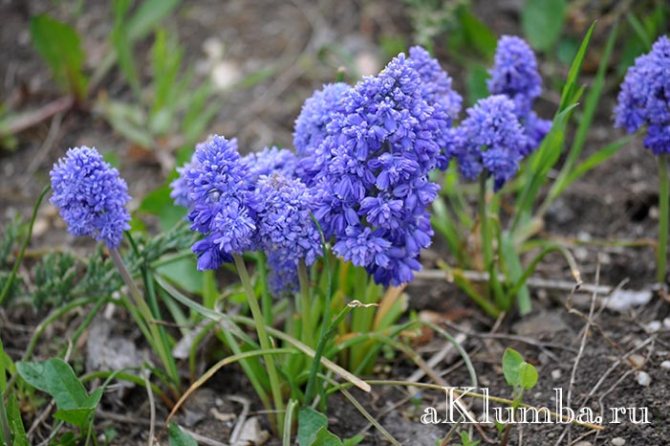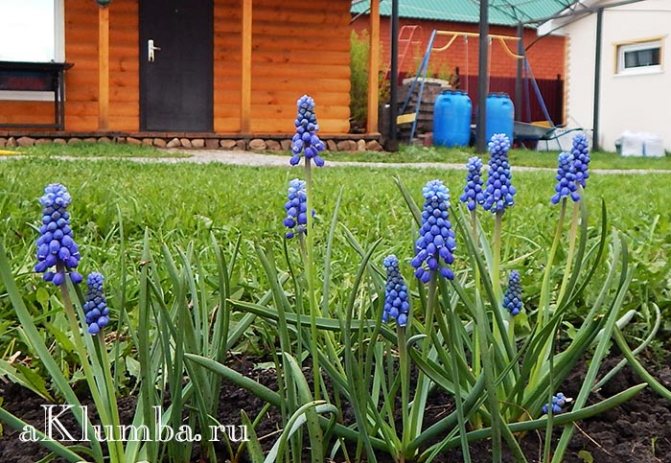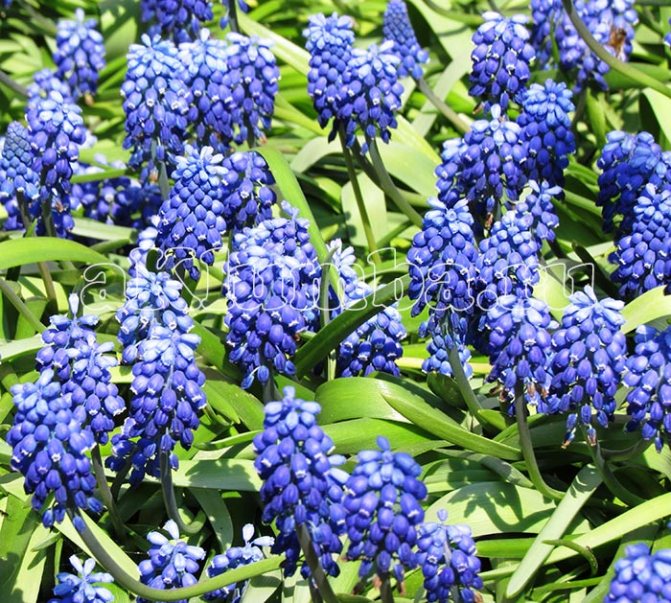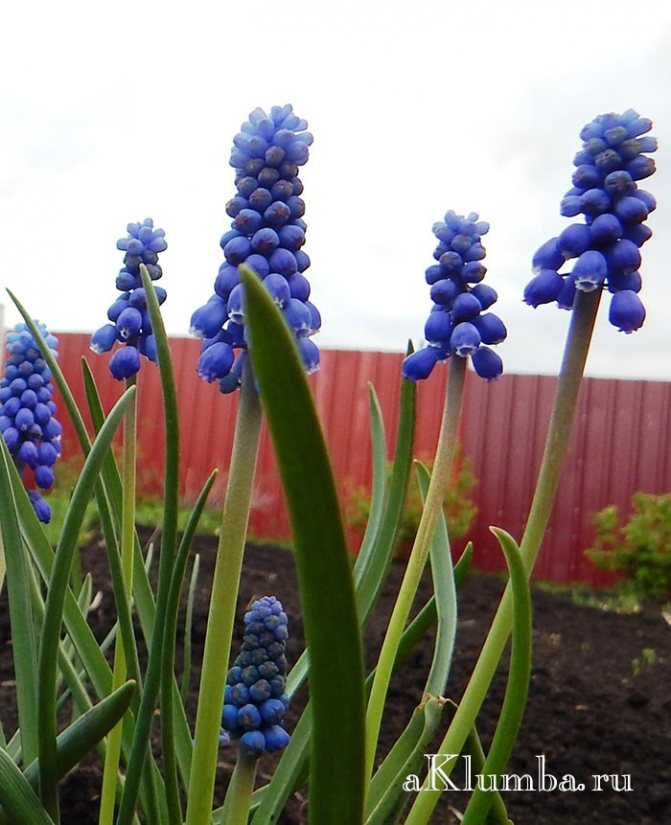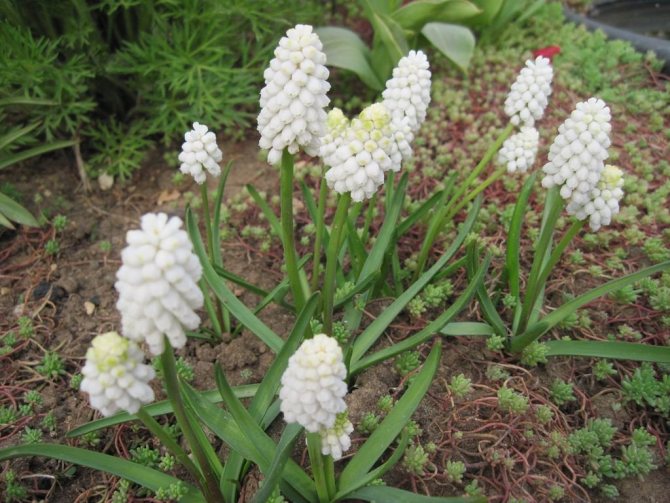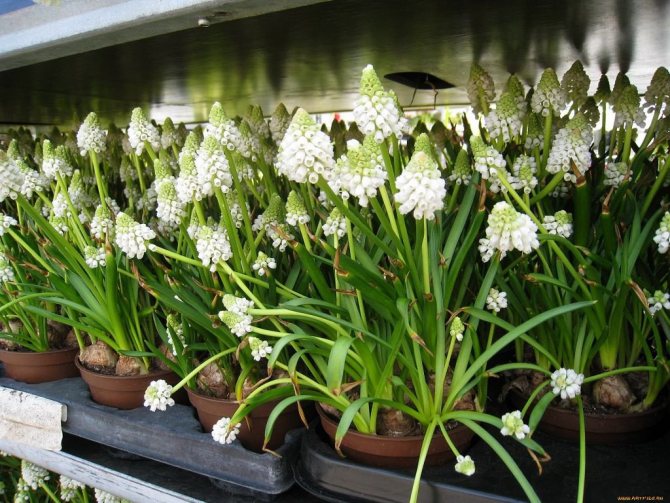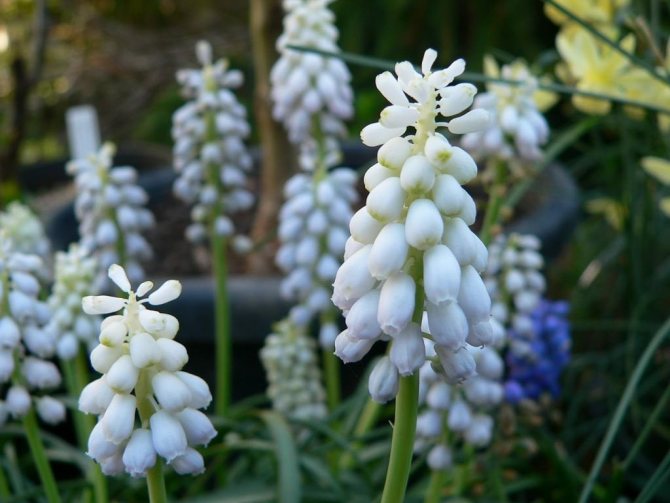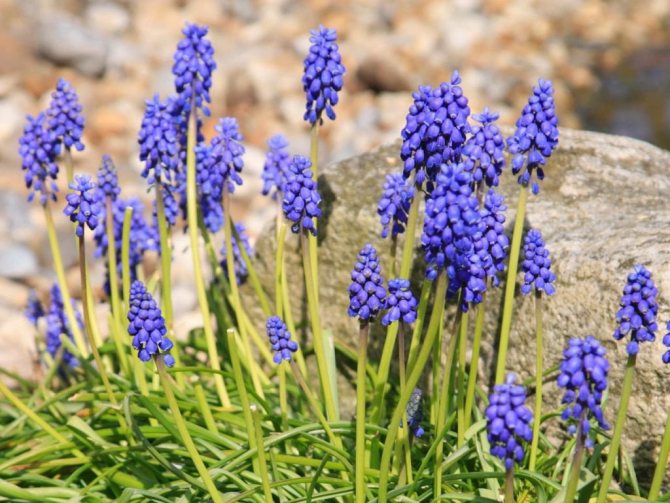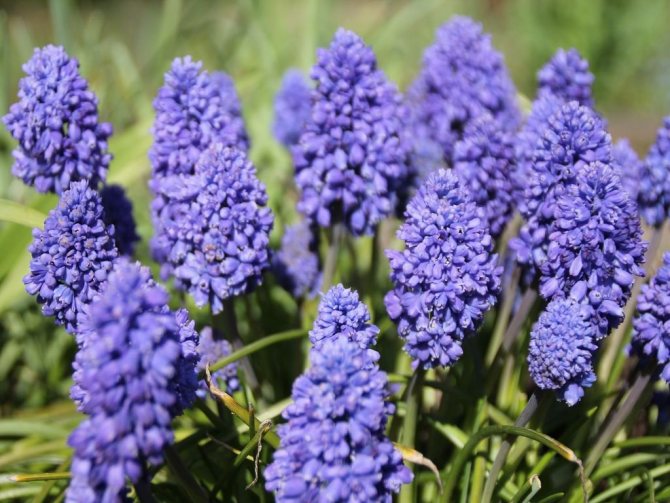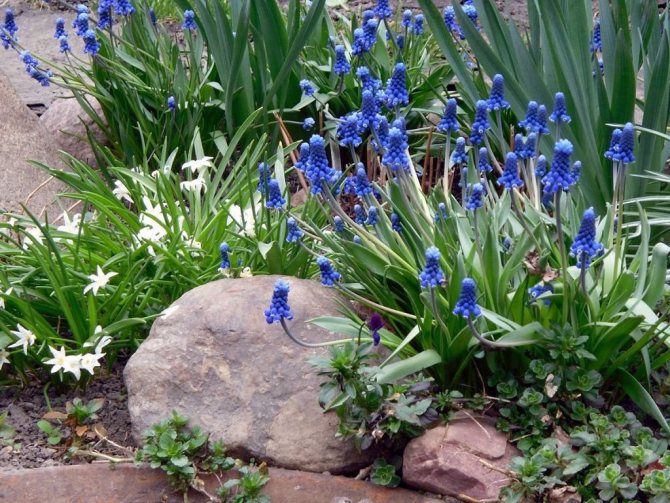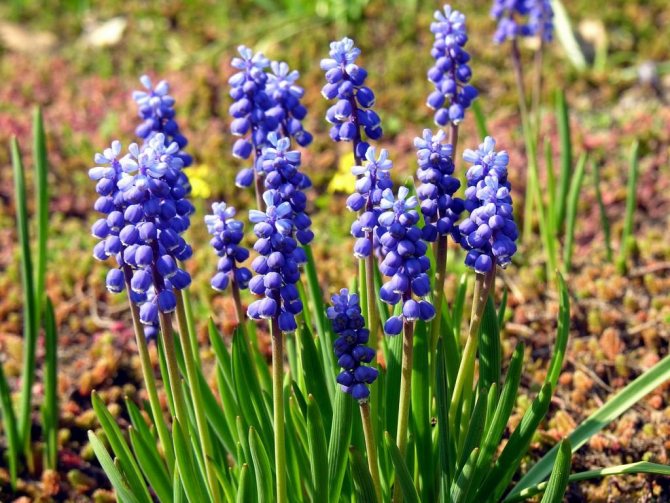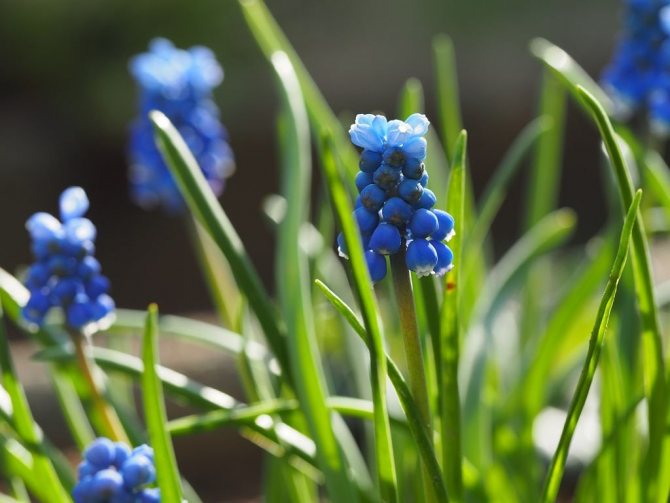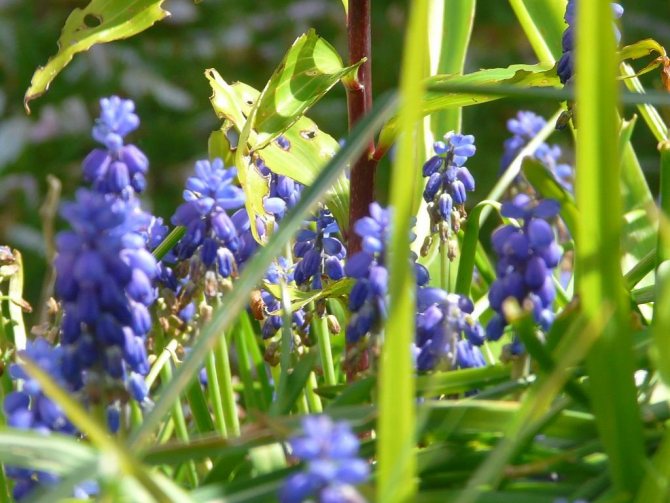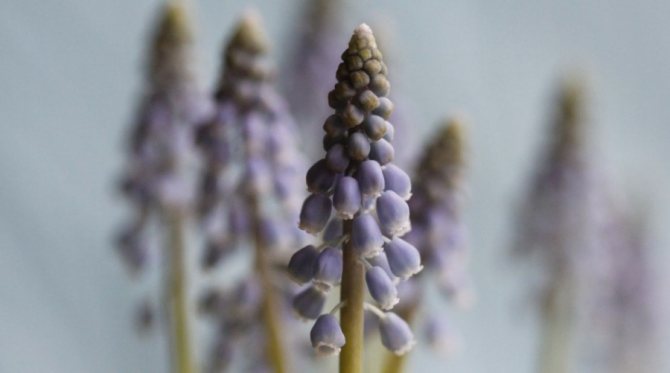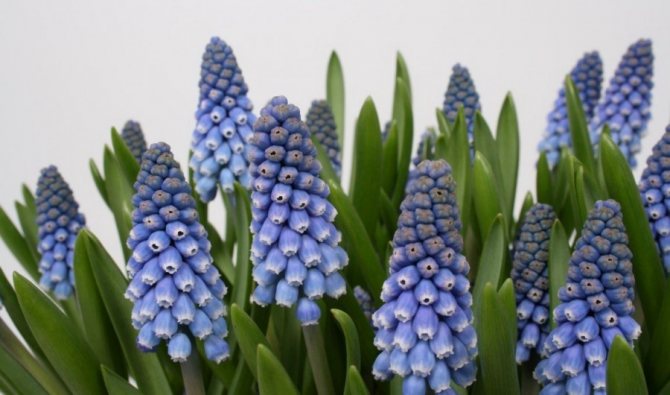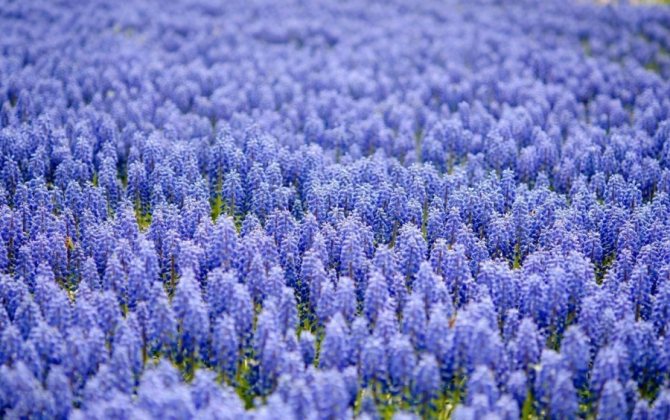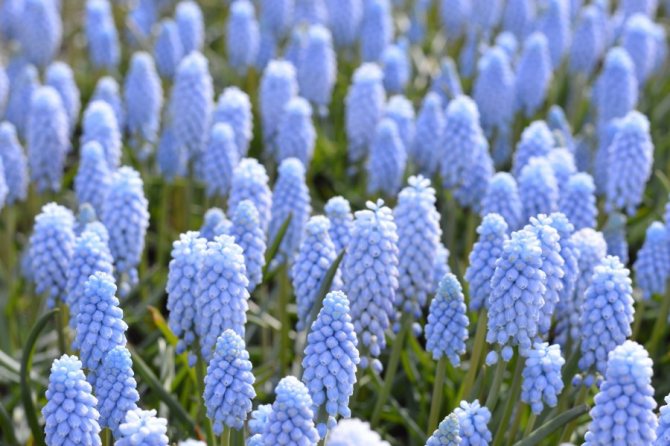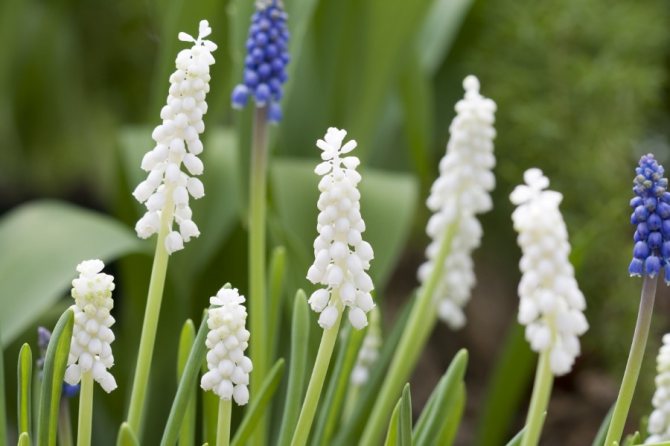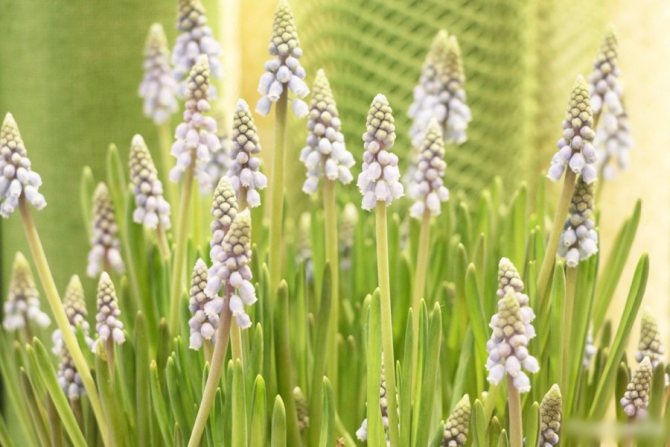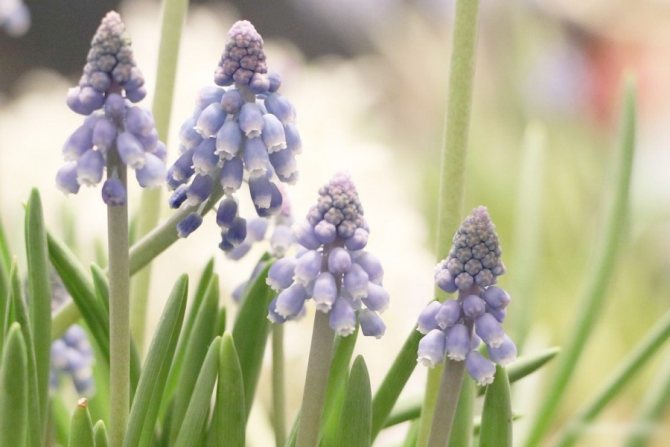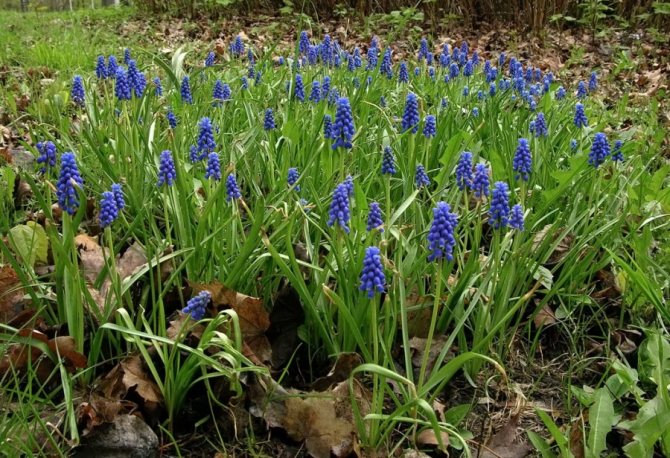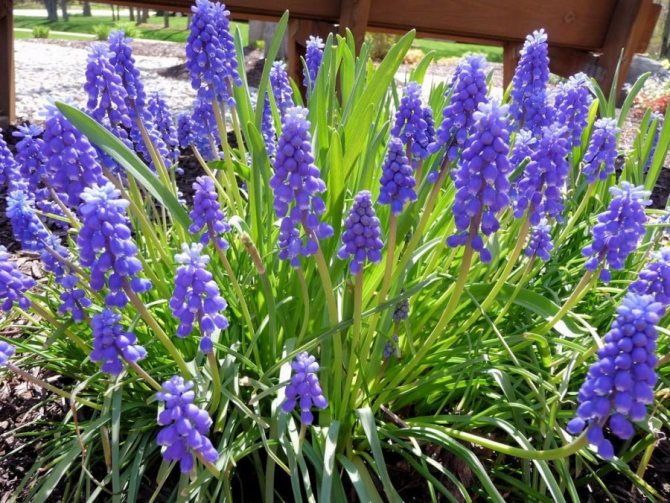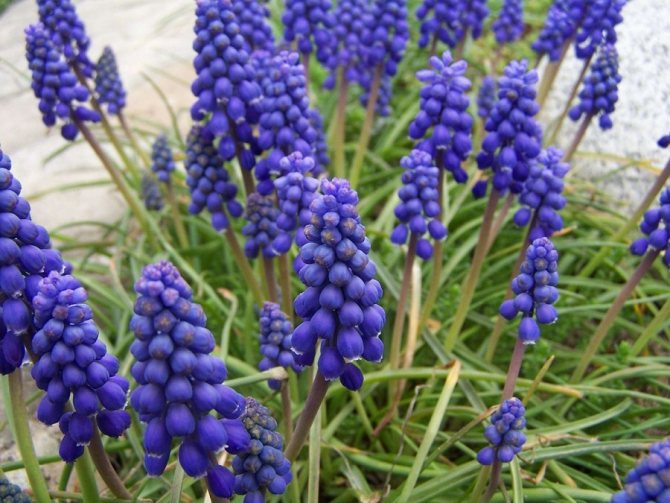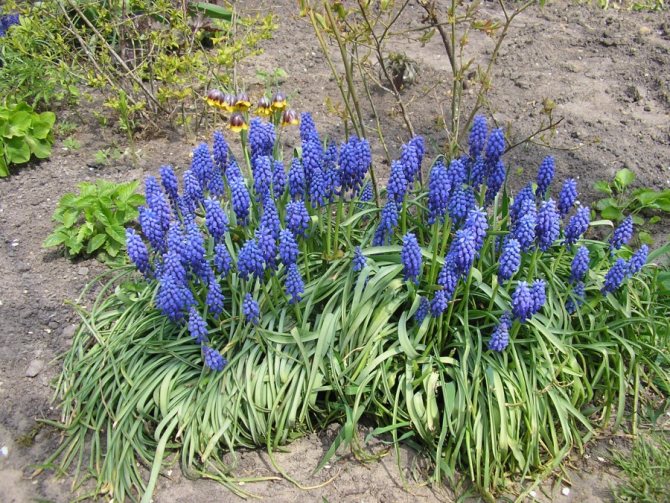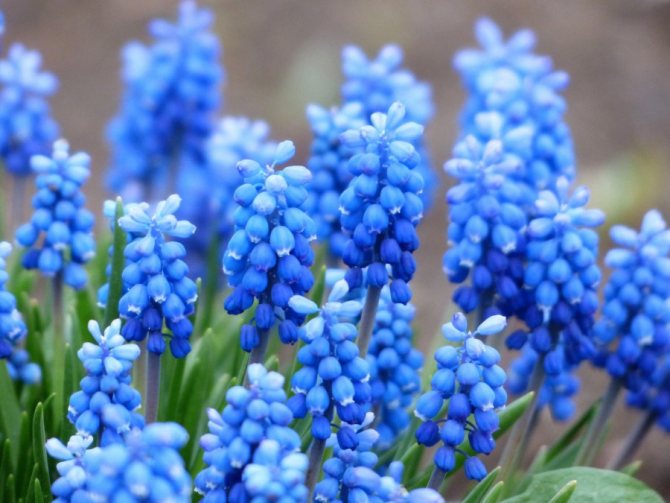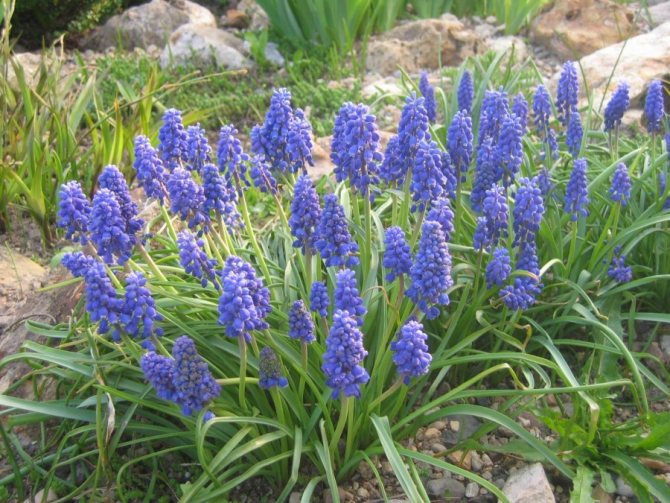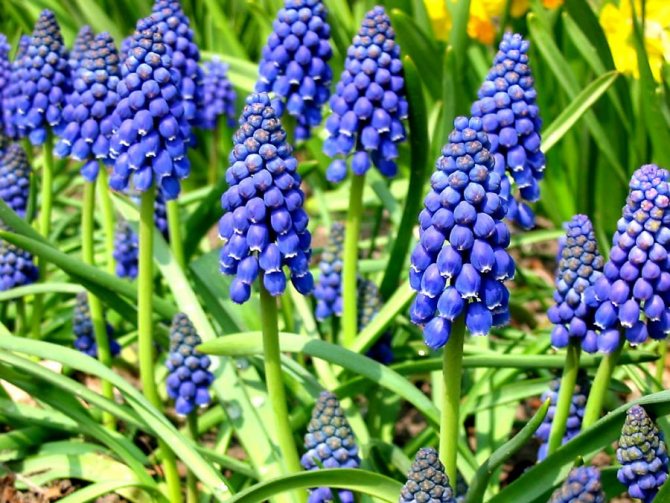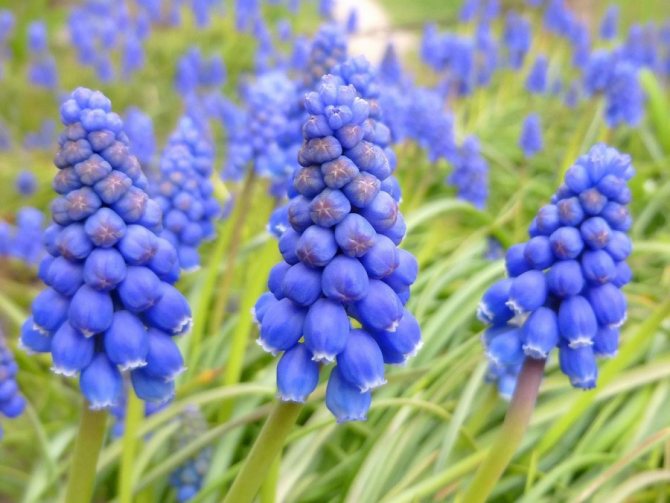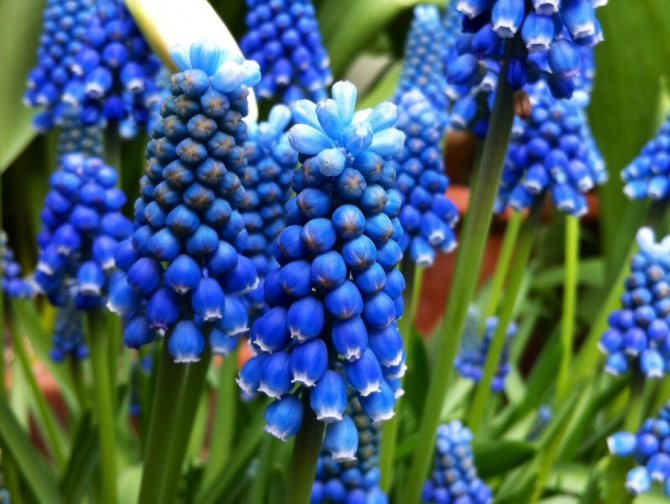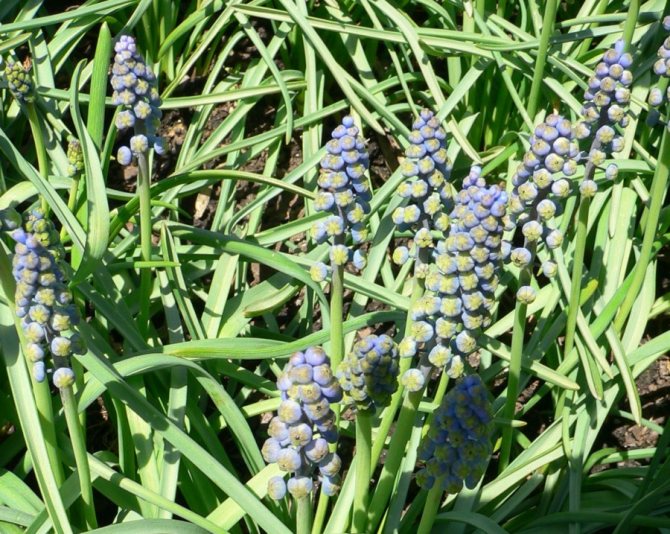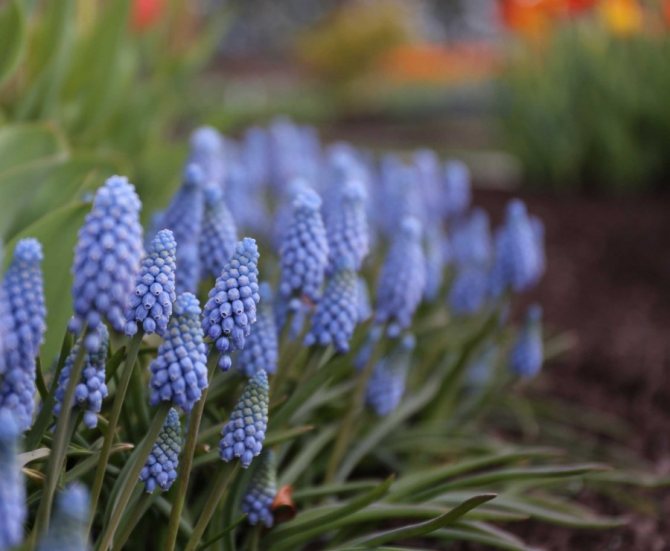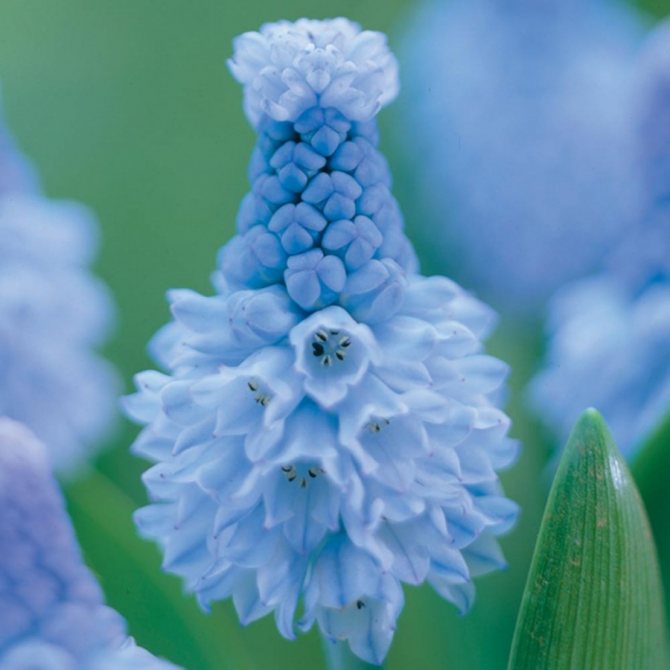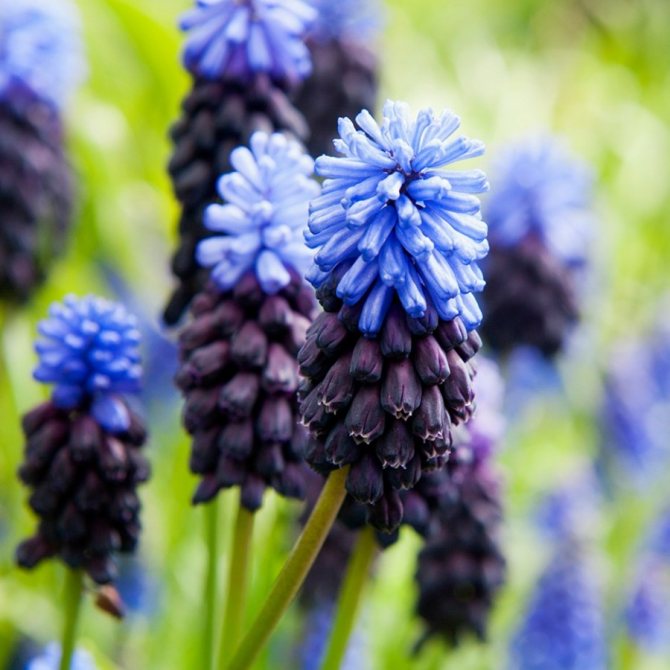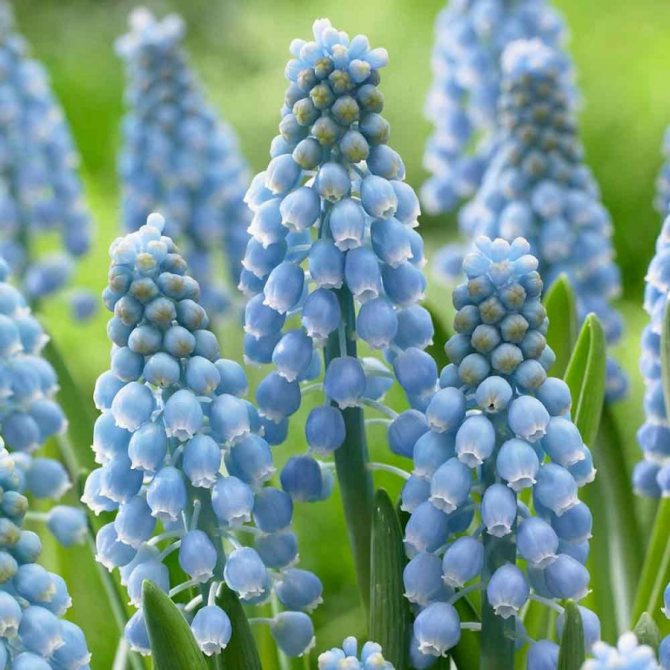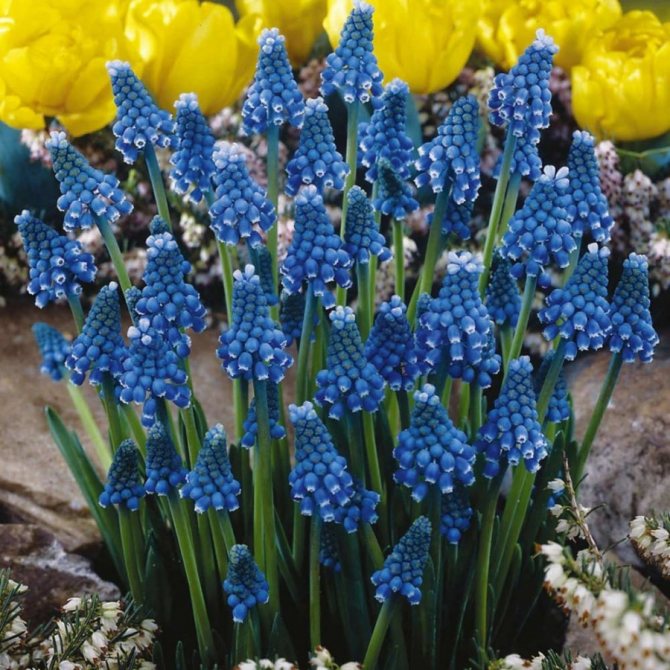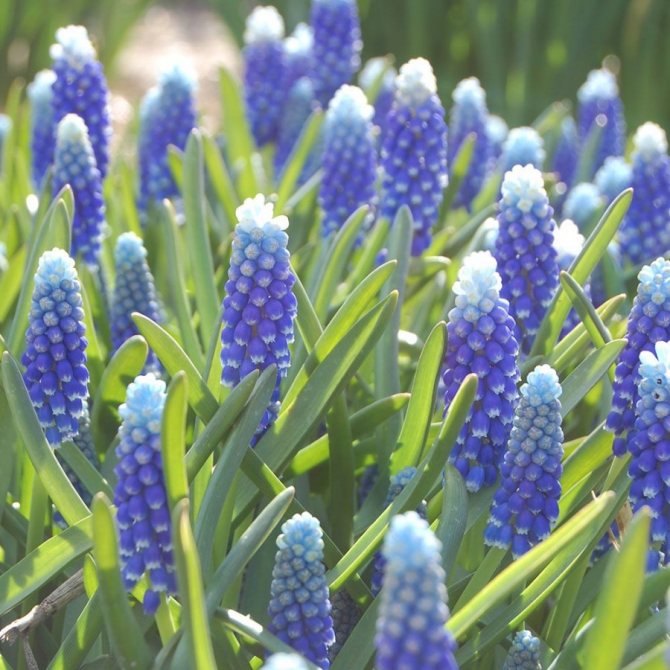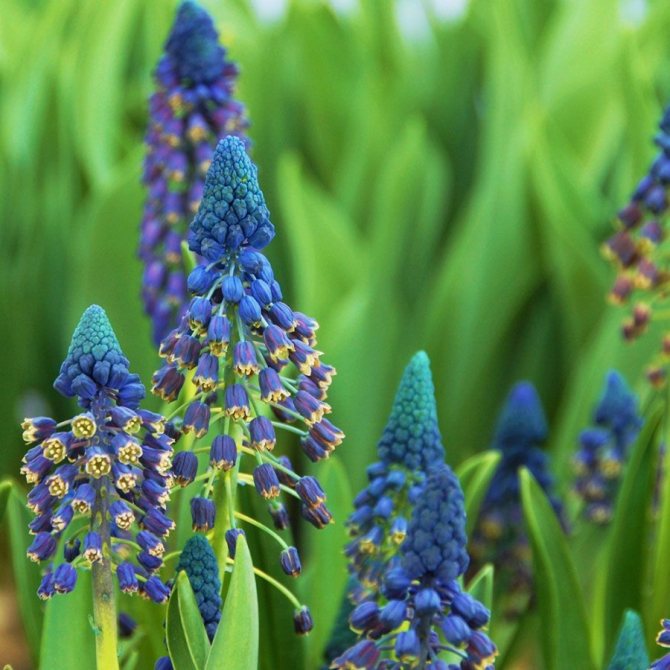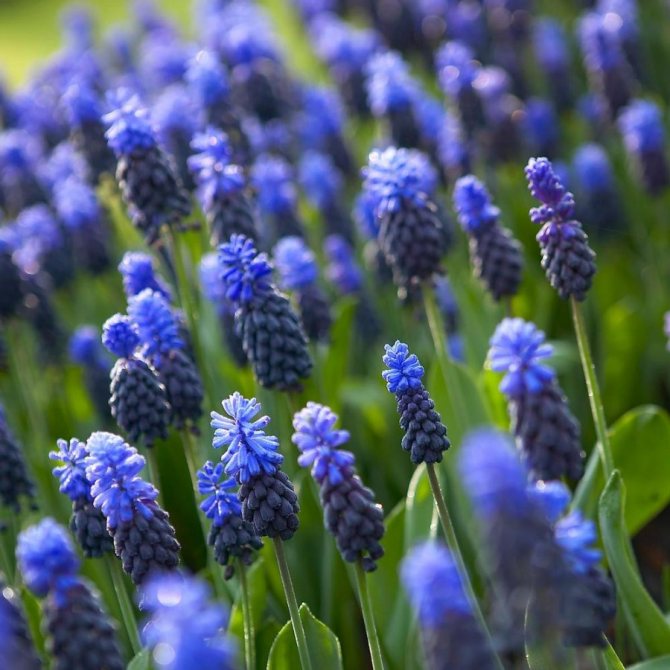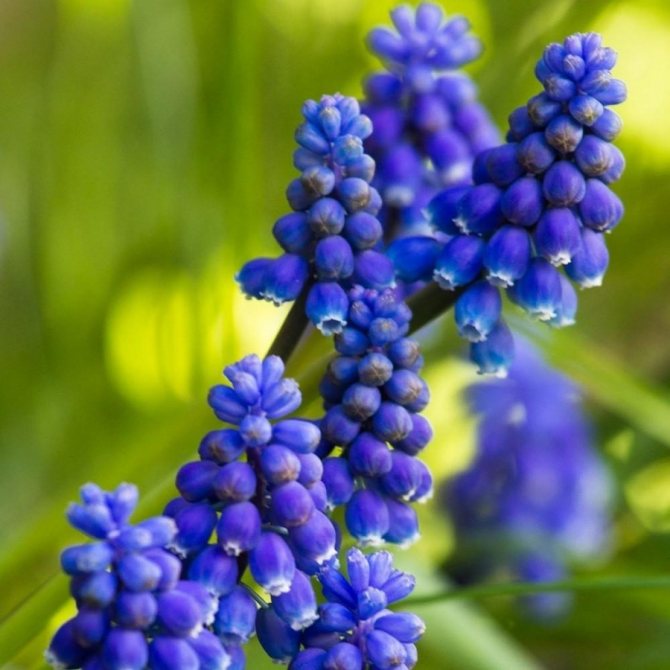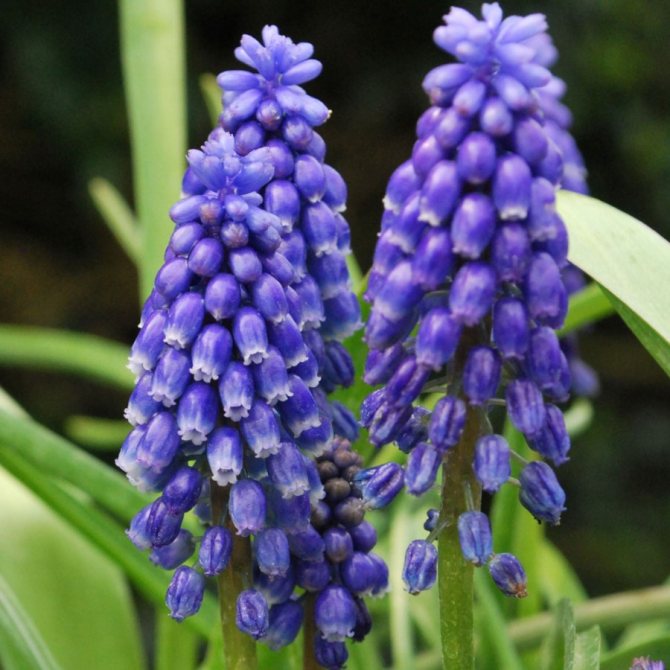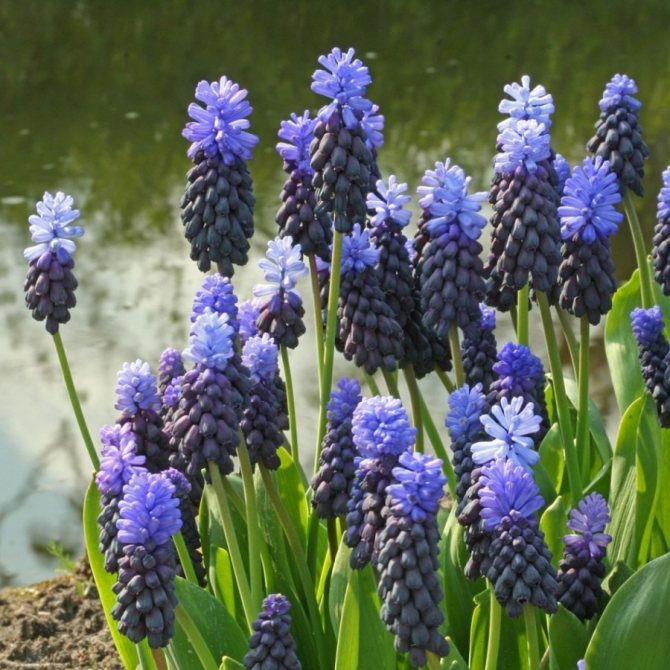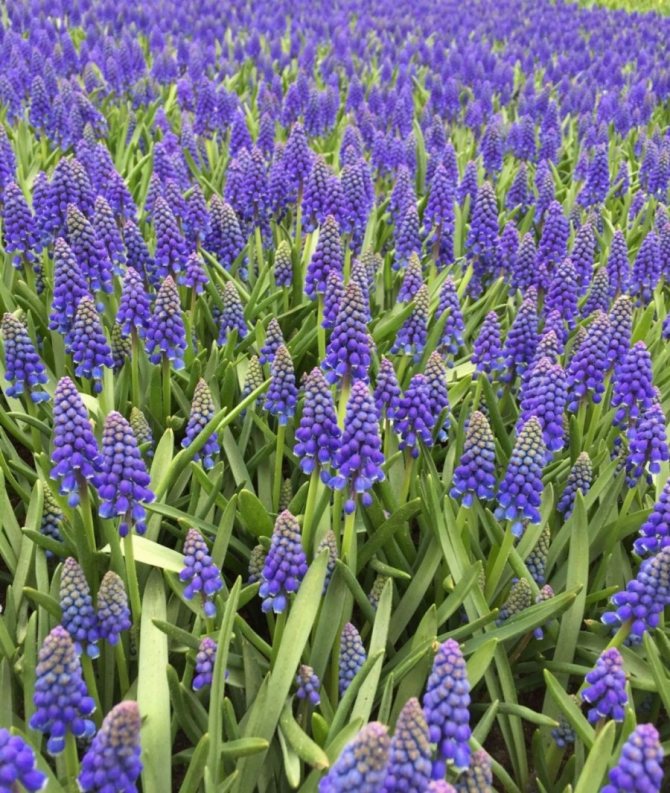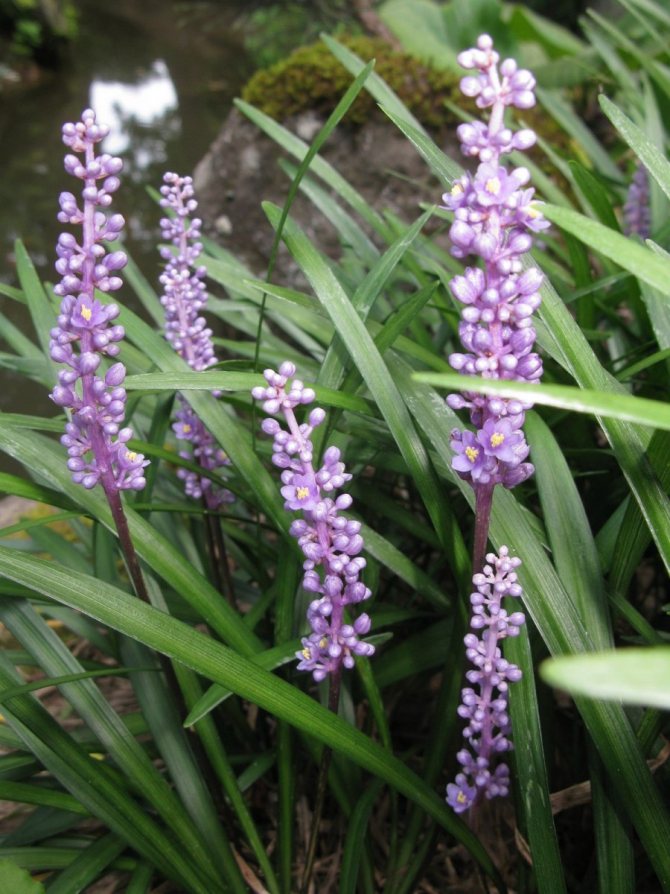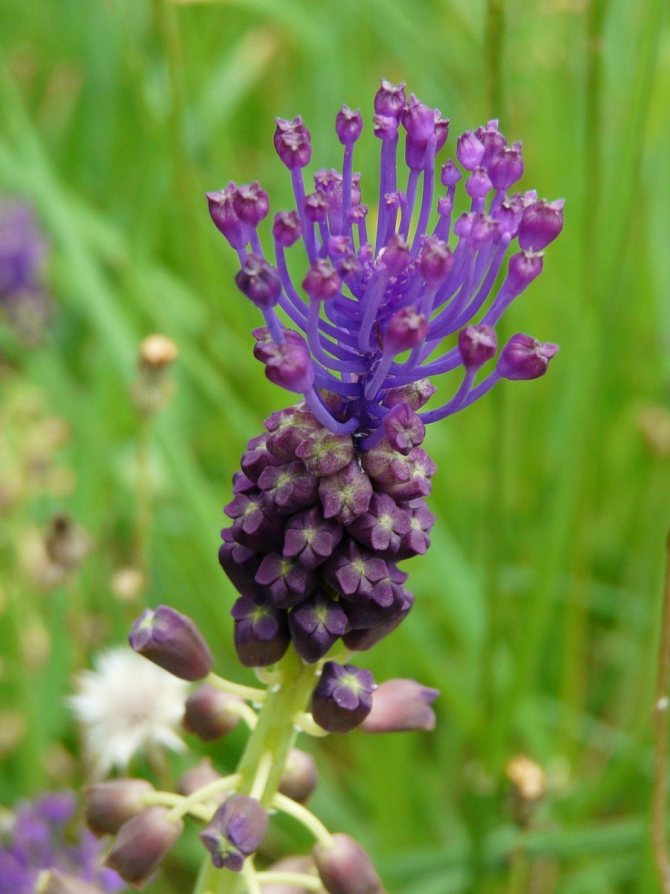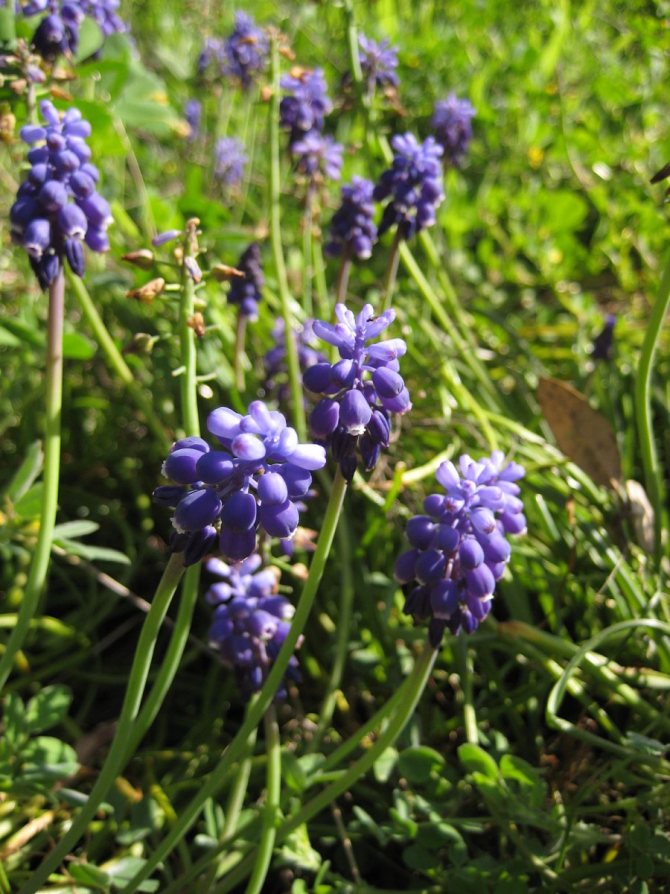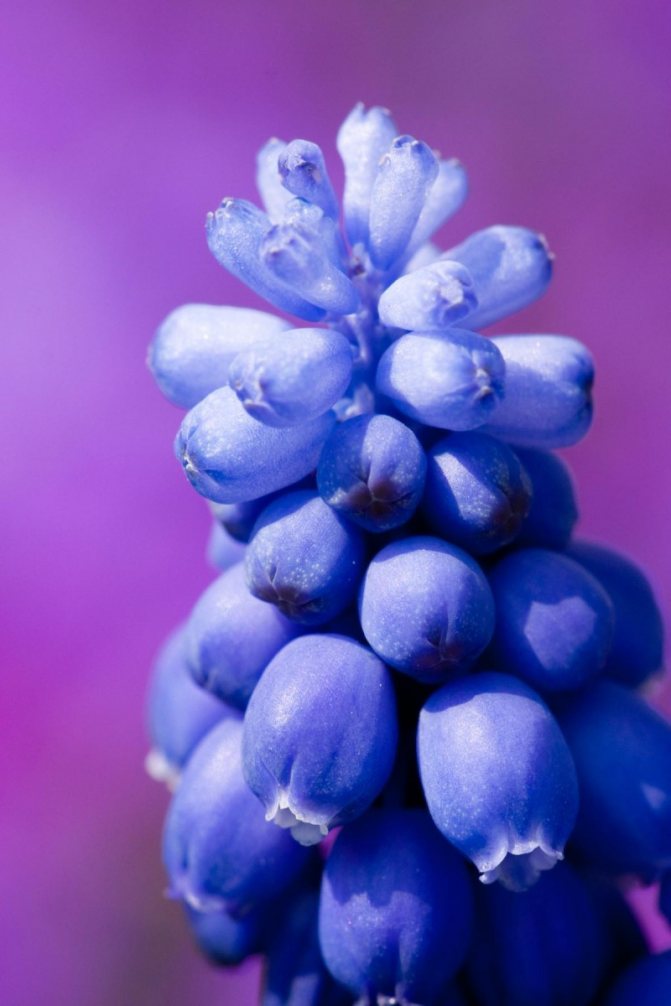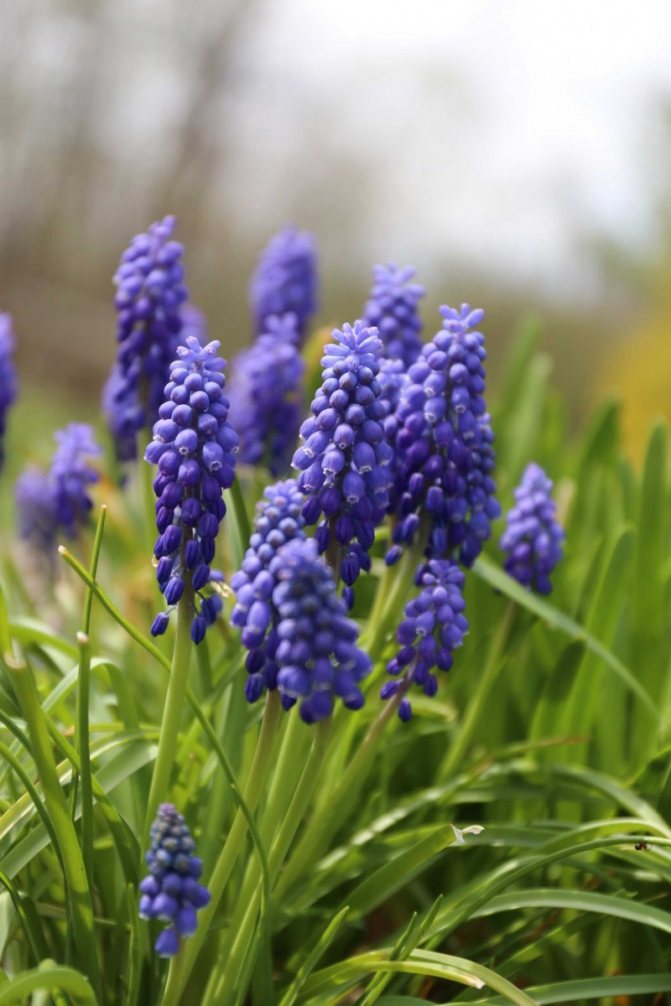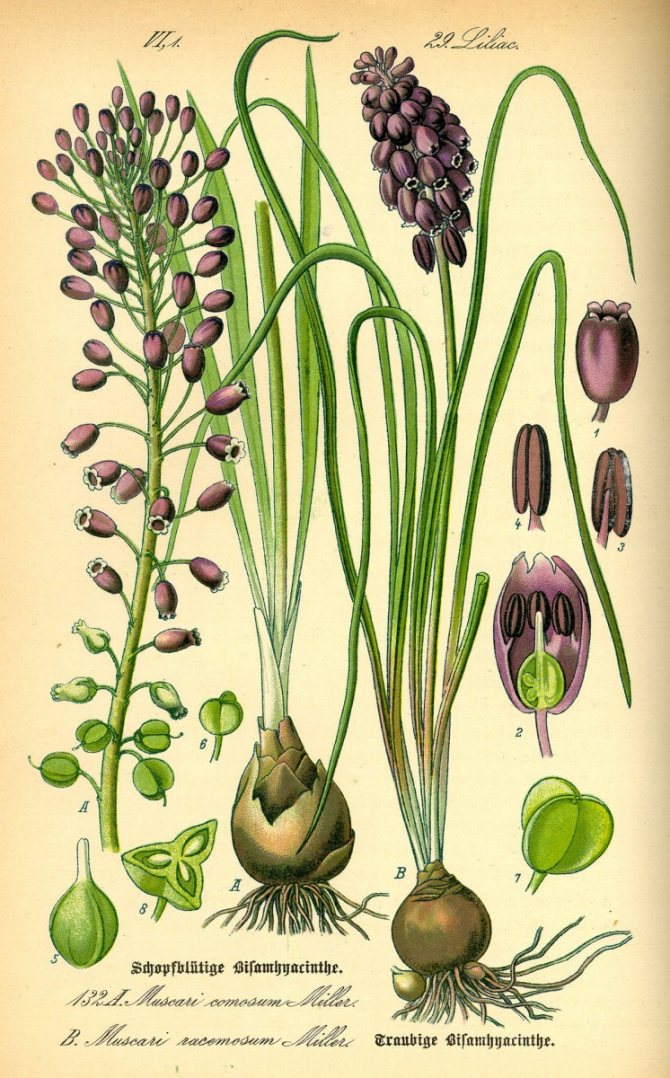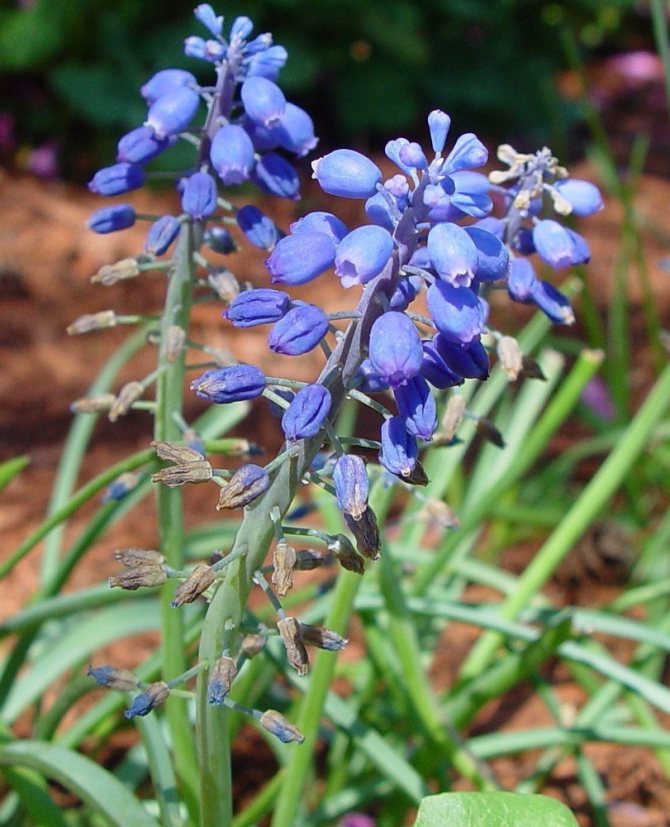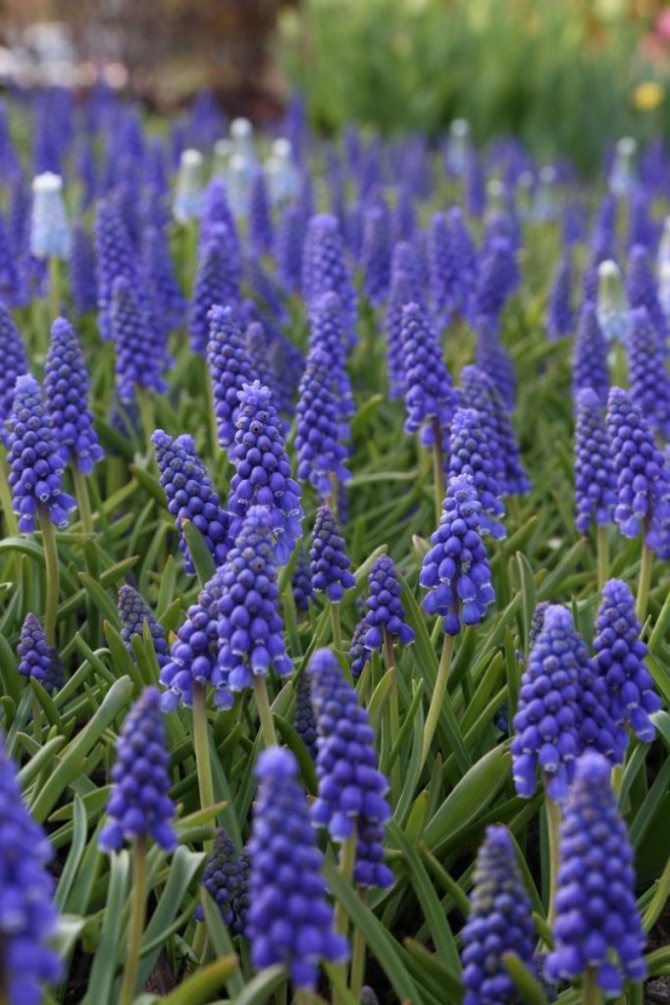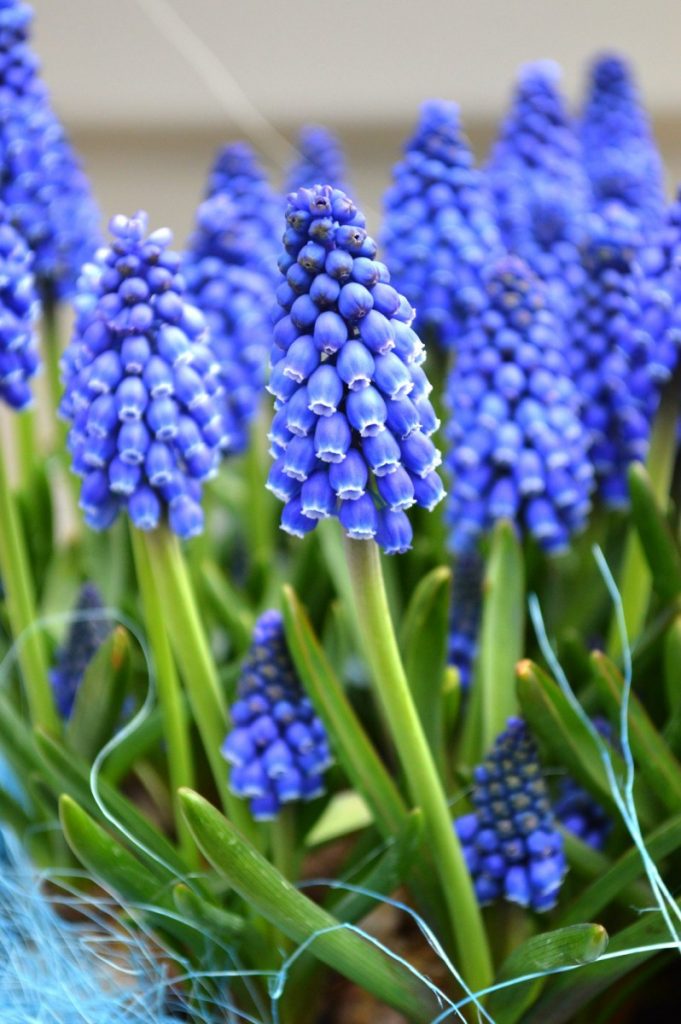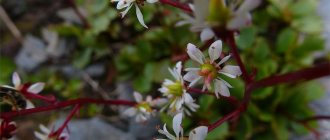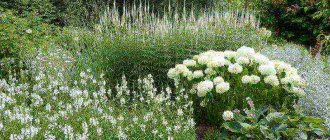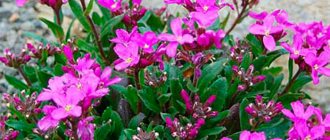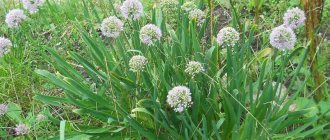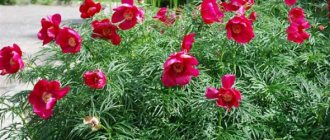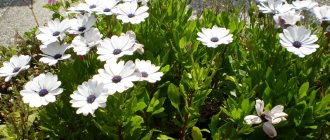Muscari (Muscari) is also called mouse hyacinth or viper onion. This bulbous perennial belongs to the Asparagaceae family, but earlier this genus was a member of the lily or hyacinth family. This genus unites about 60 species. In natural conditions, such plants can be found on the edges of forests, among shrubs, as well as on the mountain slopes of the Caucasus, Crimea, South and Central Europe, Asia Minor and the Mediterranean. These plants are among the earliest spring flowers and are very often cut. Muscari flowers have a very strong, but quite pleasant scent. Small, but very effective muscari flowers adorn lawns, rock gardens and rabatki. Such flowers are also used as border plants.
Description and features
In its natural environment, the plant is found in forests and on the mountain slopes of the Crimean Peninsula, the Caucasus, Mediterranean countries, Asia, Africa and Europe. Muscari belongs to the bulbous plants of the asparagus family. Previously, the flower was ranked among the varieties of hyacinths.
Muscari characteristics and features:
- The maximum flower height is 30-35cm.
- Leaves are narrow, long, green in color, re-grow in autumn.
- The flower stalk is tall, in the form of a bunch of grapes, with many small bell flowers of purple, blue, white and blue shades.
- The flower is resistant to sudden changes in temperature and frost.
- After the spring flowering period, the plant withers completely.
- Due to the early flowering, the plant is rarely exposed to diseases and pests.
Important! For the bulbs and flowers of Muscari, birds are not dangerous, because the plant contains substances that are poisonous for birds.
How to plant: step by step instructions
Due to the length and complexity of seed breeding, plants are most often planted with bulbs. In this case, the following rules are adhered to:
- After purchasing the bulbs, inspect them. If they have rot, mold and mechanical damage - such material is not suitable for planting.
- Treat with fungicide before planting. This rule applies to planting material purchased in the markets. In specialized stores, already processed plants are sold.
- Plants are usually planted in groups, so the distance is 5-10 cm.
- The planting depth of the bulbs depends on their size - the larger, the deeper they are planted. The maximum depth is 7-8 cm; small children are planted to a depth of 1.5 cm.
- The site for planting is dug up, if necessary, it is drained.
- Compost or humus is added.
- Immediately before planting, the soil is abundantly moistened.
- The lawn can be brightened by removing some of the top layer of the lawn and tilling the soil. After planting, the top layer is put back in place. You can use a suitable tool to pierce holes in the lawn in which to plant the bulbs.
Views
To date, more than 60 species of Muscari are known. But florists and gardeners prefer plants with resistant characteristics to temperature extremes and frost.
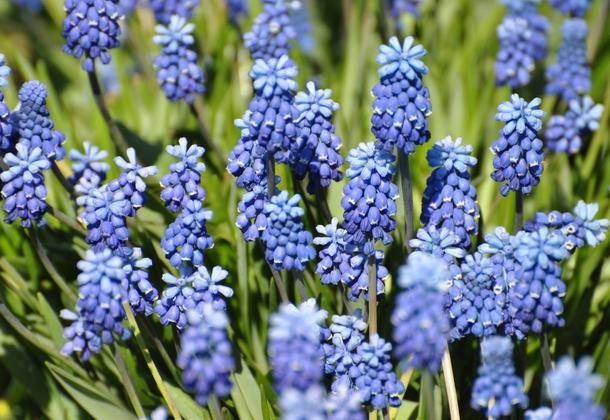
Armenian
Muscari view "Armenicum" is distinguished by its unpretentiousness to climatic conditions. The active flowering period begins in late spring and lasts about 3 weeks. Inflorescences of "Armeniacum" are dense.Blue bells with a white border at the bottom of the inflorescence smoothly transition to the lighter flowers at the top of the plant.
Grozny
The vine-shaped Muscari has been used in ornamental floriculture since the late 16th century. This type of plant has gained great popularity among gardeners, although its flowers are smaller than those of other varieties of this culture. But the color range of the grape-like Muscari variety is larger. In nature, there are blue, light blue, white and pink varieties of flowers.


Broadleaf
The species is distinguished by wide leaf plates that look more like tulip leaves. A dense inflorescence with bells of dark blue flowers forms on the peduncle. Several sprouts emerge from each of the planted bulbs of this variety.
Pale
The short plant is most often found in the mountains. Inflorescences are small, but dense, white, blue, sometimes pink.
Crested
When the crested Muscari blooms, a crest is formed in the upper part of the peduncle. Therefore, the plant has two tiers, purple bells on the peduncle itself and small purple flowers on the crest.
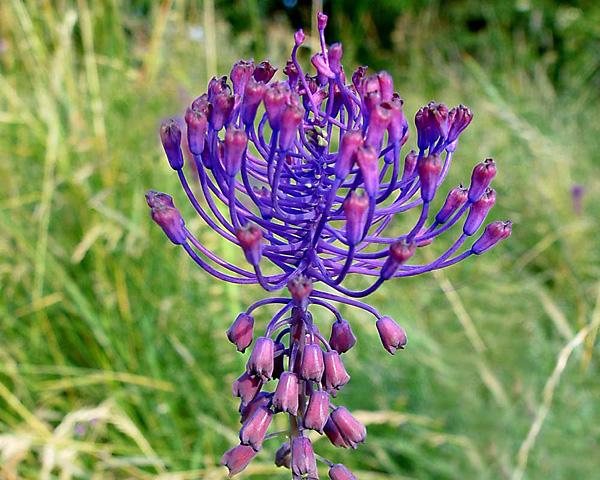

Osh
A beautiful garden pet "Osh" comes from Iran. The active flowering phase occurs in mid-spring. The inflorescences are dense, of various blue shades, occasionally there are lighter flowers, leaves of an unusual crescent shape. The flower quickly dies from an excess of moisture.
Pretty
It is the earliest Muscari species from the Mediterranean countries and enters the active flowering phase at the end of winter. A low plant with dense dark blue inflorescences.
Long-flowered
Muscari of this species is found on the slopes of the Transcaucasus and the Alpine mountain belt. The maximum height of the peduncle is 15 cm. During the flowering period, it is covered with blue bell-shaped flowers. Each inflorescence has up to 50 small flowers.
Belozevny
White-green Muscari will grow up to 20 cm. The inflorescences are dense, with dark purple flowers that have white teeth at the edges.
Large-fruited
In its natural environment, the plant is found in Greece and Turkey. The height of the flower is up to 25 cm. The active phase of flowering begins in May. Inflorescences are yellow, with a brown frame. The variety is thermophilic, does not tolerate frost.
Racemose
The racemose form of Muscari will grow up to 12 cm. The inflorescences are dense with blue bells. The active flowering period occurs in late spring and lasts 3-4 weeks.
Azure
In its natural environment, the species "Azure" meets on the mountain slopes in Turkey. The plant tolerates temperature changes well, but does not like excessive moisture. Enters the flowering phase in April. Inflorescences are dense, blue and blue shades.
See also
Planting and caring for juveniles in the open field, reproduction and rearingRead
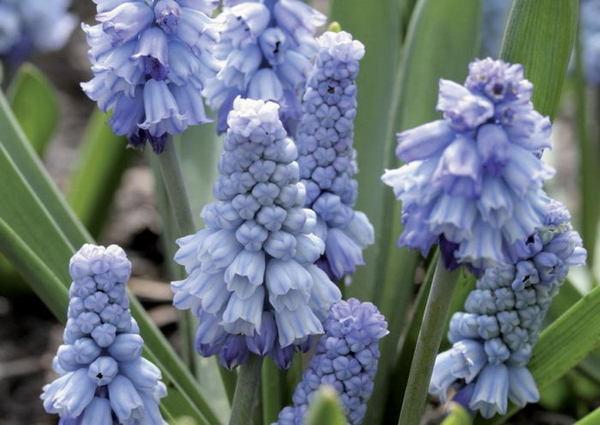

Important! Each type of plant is subdivided into varieties that differ in size, leaves and inflorescences, as well as colors.
Muscari features
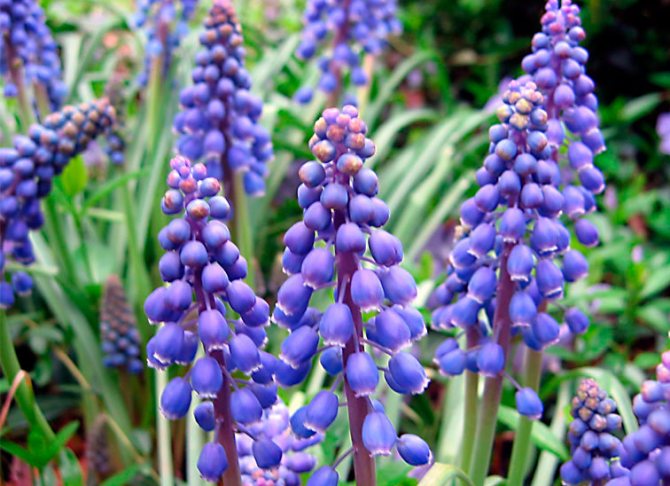

Ovate muscari bulbs have light colored outer scales. The bulbs are 20 mm in diameter and 15–35 mm long. The length of the basal linear leaf plates reaches 17 centimeters, they grow up to 6 pieces on one copy. The leaves grow in the spring, but they can reappear in the fall. In height, such plants can reach about 0.3 meters. On the leafless peduncle there are flowers, the perianth of which is barrel-shaped, cylindrical or tubular in shape, consisting of 6 fused petals, bent along the edge. The color can vary from dark blue to white. The diameter and length of the flowers are 5 mm. Such flowers are part of dense apical or racemose inflorescences, which can reach about 8 centimeters in length. The fruit is a three-celled winged capsule, heart-shaped or spherical, containing small wrinkled black seeds.The seeds remain viable for 12 months after harvest. The advantages of the muscari genus are that almost all species have a high decorative effect, and such plants are also distinguished by their unpretentiousness.
Popular varieties
Each variety of flowers has different flowering times and decorative properties. Therefore, the competent planting of Muscari in open ground will allow you to enjoy the beautiful views and pleasant aromas of flowering plants for a long time.
Blue spike
A flower up to 25 cm high, enters the flowering phase in late spring. The inflorescences are terry, branched, with multiple blue bells. One inflorescence accommodates up to 170 flowers.
Cantab
Perennial Muscari variety. The active flowering phase begins in May. The inflorescences are dense, with blue-blue flowers.
Christmas pearl
The variety "Christmas Pearl" is distinguished by beautiful, large inflorescences of purple hues.
Flight of fantasy
Unusual Muscari variety with greenish and blue flowers.
Dark eyes
The variety grows up to 25 cm, the leaves are narrow, dark green in color. The flowering period is late spring. Inflorescences are dense, blue shades, white border on the tips of the bells.
Plumosum
The Komosum Plumozum variety belongs to the crested Muscari species. The flower is distinguished by its decorative, shaggy appearance and pleasant aroma.
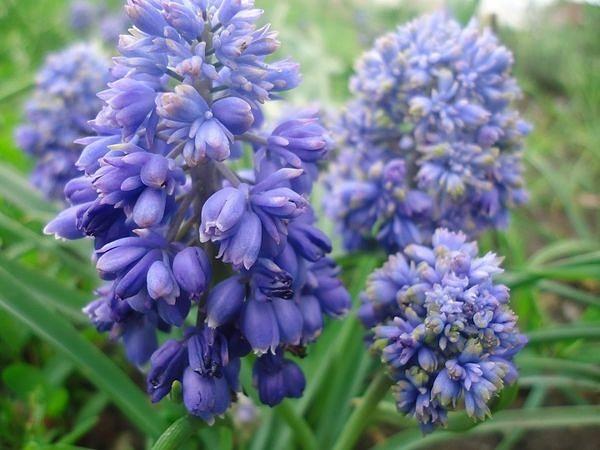

Sky blue
Perennial Muscari variety. Inflorescences are dense, bell-shaped flowers are blue, with a light pleasant aroma.
Sapphire
Frost-resistant grade. Active blooming begins in April. Inflorescences are dense, with small blue bells with a silvery tinge.
Alba
White inflorescences of the "Alba" variety will decorate flower beds and spring garden compositions. It enters the active flowering phase in March.
Big smile
The variety is distinguished by large inflorescences up to 12 cm in light blue shades with a white frame around the edges. It begins to bloom in mid-spring. The flowering period is 2-3 weeks.
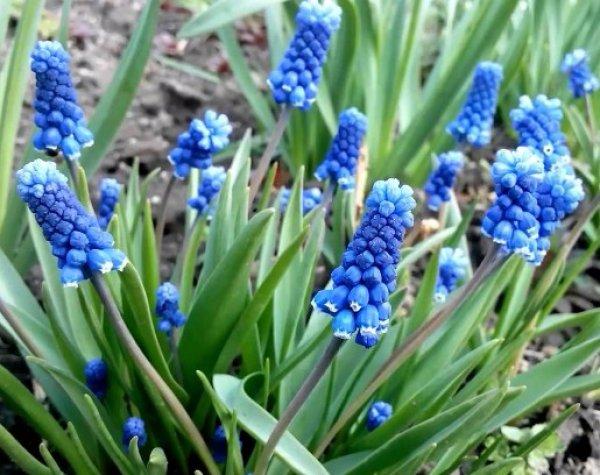

Razletayka
Muscari varieties "Album" are suitable for decorating alpine garden landscapes and flower beds. The plant blooms in mid-spring. Inflorescences are dense, white.
Muscari Armenian and other varieties
Is earth lilac a cultivated or wild plant?
Mouse hyacinth grows wild: on slopes high in the mountains, in the steppe next to other herbaceous vegetation, in meadows and along the edges of forests, in thickets of bushes.
There are 40-60 domesticated and wild species in the genus of viper onions, the most widespread garden varieties:
- Armenian muscari Is a fairly popular plant. It grows large blue and white inflorescences. This species is more frost-hardy than others.
- Blue spike with double flowers, up to 170 bells bloom in a bunch;
- Fantasy creation has bluish green colors;
- Christmas pearl with purple flowers;
- Azureu with azure buds;
- Cantab - these are compact plants with bright blue flowers;
- Sapphire - the inflorescences are blue, but, unfortunately, these plants do not have seeds, since all flowers are sterile.
- Muscari Tubergena - this is bicolor, the flowers are bluish on top, bright blue below;
- Grape-shaped muscari with pinkish inflorescences - Carneum or white - Album;
- Racemose muscari, they have purple buds;
- Crested muscari, flowers from blue to snow-white;
- Broadleaf (Latifolium) has wide foliage, several peduncles can grow from one bulb.
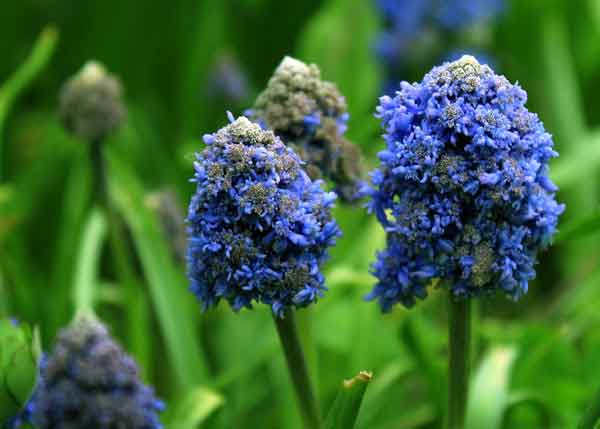

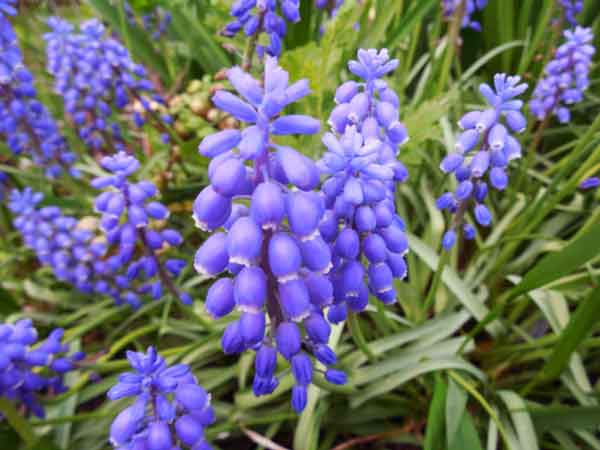

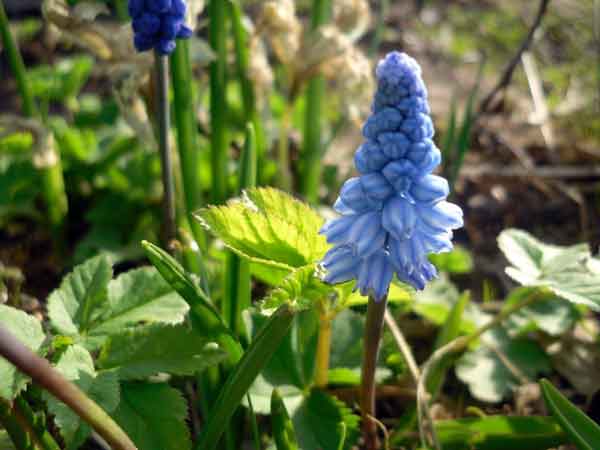

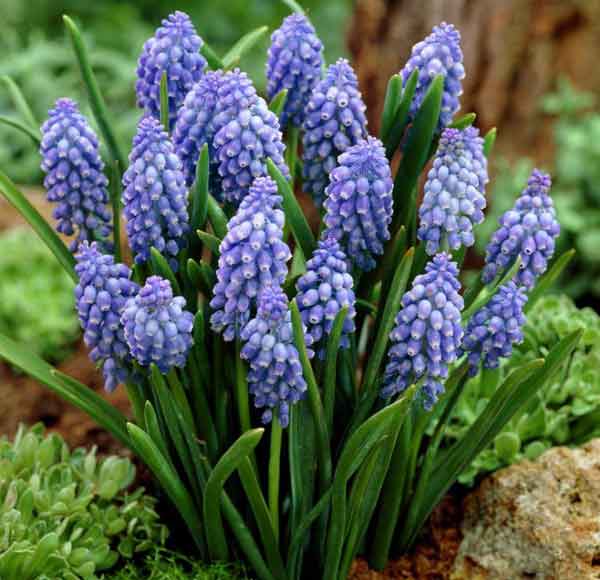



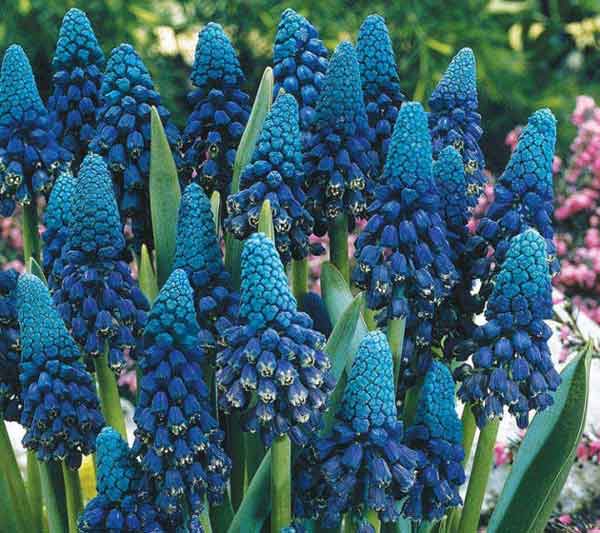

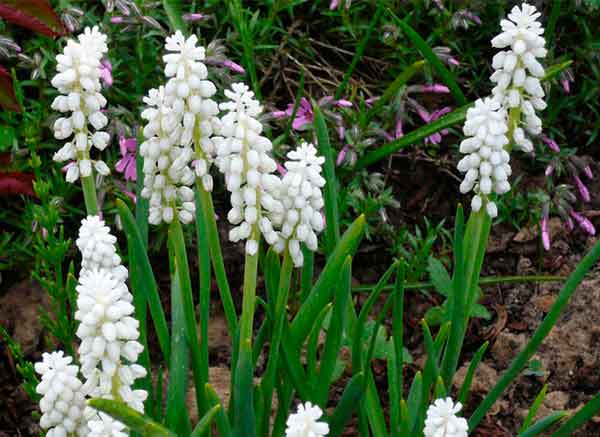

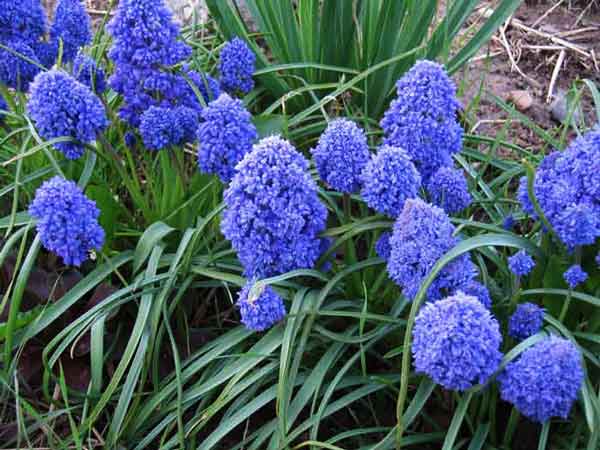

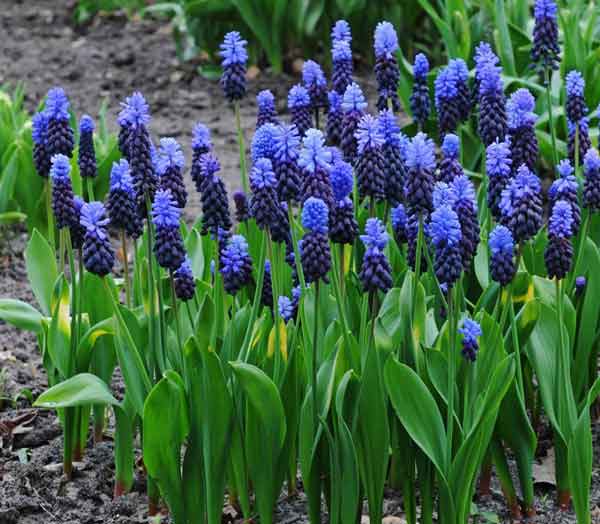

Growing in the garden
Muscari is an unpretentious plant and does not require special care. The flower grows in its natural environment in difficult conditions of mountain slopes and forests. Therefore, the plant is undemanding to the composition of the soil and grows even in the most infertile areas.
When to plant
The bulbous culture is planted in open ground in the fall. But if the autumn works are missed, then the flowers can be planted in early spring.
Before planting the plant, the soil is thoroughly loosened to a depth of 8 to 10 cm.
How to plant
Before planting the bulbs in open ground, they are examined. There should be no obvious damage or signs of decay on the seed. Next, the bulbs are poured with a manganese solution or other disinfecting agents and left for 30-40 minutes. Planting holes are prepared in advance and watered. The depth of the holes is 7-10 cm. The larger the bulbs, the more they should be deepened. Small bulbs are no more than 3 cm deep.
A distance of 5 to 10 cm is observed between the holes.
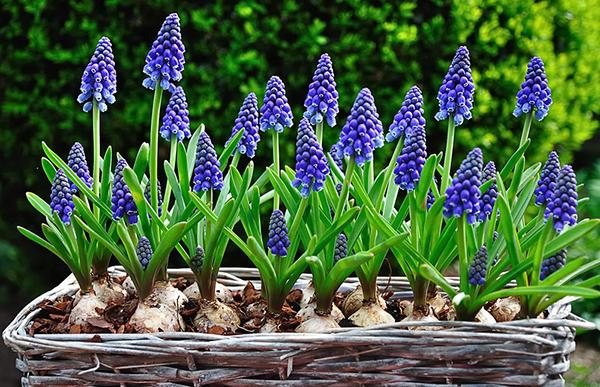

Important! It is in large groups that Muscari give the best decorative result.
How to grow in a container
The bulbs are planted in a plastic pot in the fall. If you plant it not in a container, but directly into the soil, then when removed from the ground, you can destroy the plants by damaging their delicate roots. In the pot, be sure to first make holes for drainage, then drop it on the site.
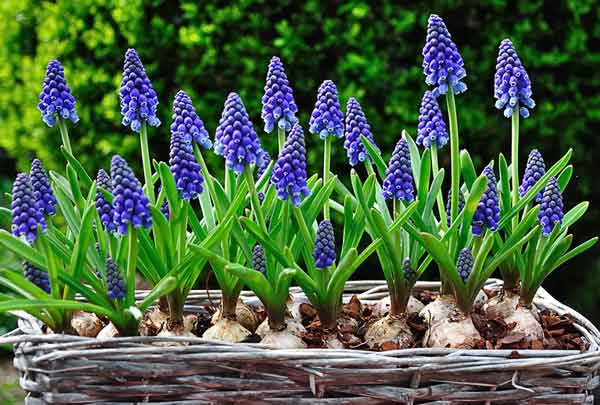

In spring, mouse hyacinths are transferred with a lump of earth from a pot to a pots (its difference from a pot is that it has no drainage holes, and it can also be hung, as a result, the plants in the apartment look very decorative).
When the viper onion blooms in a flowerpot, it is more often watered and fertilized than the muscari growing in the garden. After the plants have faded, they are again transplanted into a pot and buried in the ground, left for the winter.
Care features
To obtain large flowers with bright inflorescences, lime is added to the soil with a high acid content. The plant will develop on acidic soil, but the decorative properties will be lost. The plant does not tolerate waterlogging of the soil, so it is planted away from ground and soil waters.
Watering
Active growth begins in early spring, when the soil is well moistened after winter precipitation and rains. And since the flower does not like an excess of moisture, it does not need systematic irrigation. Water the plant only if necessary. If there is no precipitation during the active flowering phase, then the plant needs additional soil moisture.
Top dressing
If there are no nutrients and useful substances in the soil, the plant is fed with organic fertilizers. In autumn, the soil is mixed with humus.
Bloom
The flowering time of Muscari differs from its variety and varieties. Some plant varieties bloom at the end of February, there are species that enter the flowering phase only in June.
Transfer
A spring flower is transplanted every 5 years. On a well-groomed and fertile soil, the plant can not be touched for up to 10 years, but then you still have to transplant. Muscari tolerate a change of place well, therefore, for decorative purposes, sprouts that have already grown from the bulbs can be transplanted.
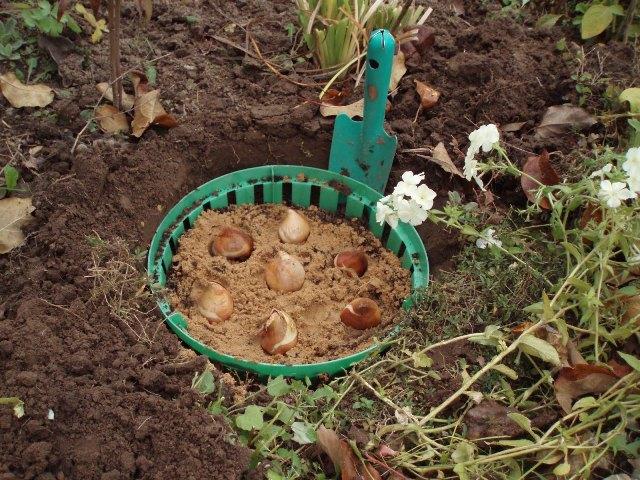

Distillation
Each crop variety has its own flowering period. Therefore, for forcing plants, bulbs of the same varieties are selected.
Features of forcing mouse hyacinth
The bulbs are dug out after the foliage has fallen, they are washed, sprayed with Fitosporin. The largest bulbs should be selected, having a diameter of 6-10 cm.
You need to check that they are healthy. The bulbs need to be dried a little at room temperature and placed in a well-ventilated and dry visit (t = + 20 ° C) until September.
You should be careful about when to plant the bulbs depending on when you want the plants to bloom.
Attention! They need 3-4 months of exposure at a low temperature, and another 2-3 weeks for distillation.
First, place the bulbs in dry sawdust, cotton wool or paper, and place in a + 9 ° C room for 35 days. And then lower the temperature to + 5 ° C, for this you can put them (onions wrapped in paper) in the refrigerator.
After the mouse hyacinth is planted in moistened soil in pots, the bulbs are buried 2 cm so that their top remains in the air, they are placed = pots with plants in a cold place (t = + 5 ° C) for 2 weeks. The soil is made by mixing forest, peat lands, sand or perlite. A pre-broken brick, expanded clay is poured at the bottom of the pot.
Then the pots are placed in a room (t = + 10 °), then after 1-3 days the temperature is increased to + 15 ° C. If the ground dries up, then it is watered, but so as not to fall on the bulb. And after another week, the air temperature is made about + 25 ° C, otherwise the culture will not bloom.
The inflorescences bloom from the viper onion within 10 days. And this video tells about how to plant a viper onion in a flower bed in the fall:
Reproduction
Even a novice gardener or florist can cope with the reproduction of spring flowers on a personal plot.
See also
Description of the 15 best types of annual flowers to give blooming all summerRead
Vegetative way
During the season, up to 30 babies are formed at the mother's bulb, which are carefully separated and seated.
Self seeding
Muscari has the ability to reproduce independently. After flowering, seed pods are formed, which open and the seeds fall into the ground. To control the number of Muscari livestock, only a few plant specimens are left and after the seeds ripen, they are harvested.
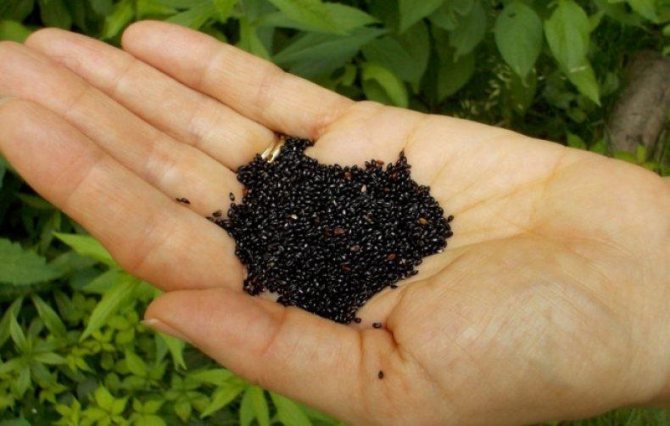

Reproduction of earthen lilac
Basically, flower growers breed muscari vegetatively, but in industrial greenhouses they also propagate by seeds. They are first sown indoors, and then transplanted seedlings in a greenhouse.
Growing muscari from seeds
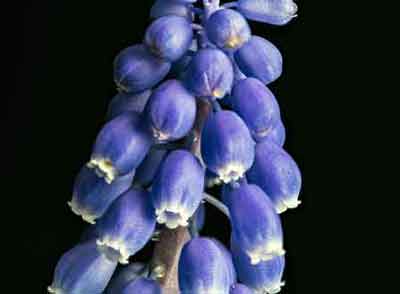

In the most powerful and healthy muscari, they leave flower stalks, wait for the seed boxes to ripen.
They are collected from the lower shoots. Grooves are made to a depth of 1-2 cm.
Fall asleep seeds in the fall, sprinkle with soil.
In the spring, young sprouts grow and bulbs begin to form.
The bulbs are formed within 3 years.
Vegetative breeding methods
Dig the bulbs that are 2 to 5 years old. This is done after the foliage is completely dry. Then the children are carefully separated and planted in the ground. Such plants begin to bloom 2 years after planting.
Storing muscari bulbs
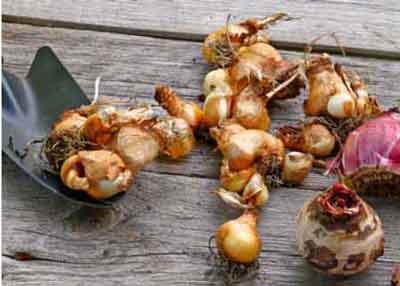

If you want to save the bulbs until next year, then to plant them in a flower bed, then:
- they are dried for 4-6 days;
- peat or river sand is poured into the boxes, the bulbs are moistened and put;
- they are constantly examined and soft bulbs are thrown away; those that are damaged; rotten.
Viper bow calmly withstands low temperatures in wintereven if not covered. It is loved by flower growers for simple care, early blooming of buds. After flowering, the bulbs are dormant in the ground, they almost do not need care.
Diseases and pests
Most varieties of this plant, due to the early flowering period, are not susceptible to diseases and pests. But there are times when troubles happen with spring primroses.
Mosaic
The main cause of the disease is an infected flower bulb. With a disease of green or cucumber mosaic, peculiar patterns appear on the leaves, and they themselves are deformed.
Aphid
Poor-quality planting material may be infected with aphid larvae that are in the bulbs of plants. In this case, the plant must be dug up and destroyed to avoid further contamination of neighboring flowers.
Spider mite
Muscari is rarely affected by spider mites. But if such a case occurs, then the plant requires urgent inspection and processing. For the prevention of diseases and pests, plants are sprayed with soapy water or special preparations.
Care rules
It must be planted in such a way that the bulbs do not get wet. The choice of soil is unpretentious, as long as it is not heavy, clayey and does not retain moisture.
It should be borne in mind that on fertile soils, muscari forms a larger bulb and blooms more profusely.
The plant needs abundant watering at the beginning of the growing season, in the future it tolerates drought well.
It grows well in a bright sunny place, forming whole glades. Worse - in partial shade.
Prefers organic fertilizing. Usually, top dressing is applied directly to the soil before planting the bulbs or before flowering, during the active growing season. To make the curtain with the plant look neat, the faded inflorescences are removed.
They are planted, separating part of the daughter bulbs together with a clod of earth, and transferred to a new place.
The division time is determined by the appearance of the curtain - the plants begin to jam each other, the flowers and leaves become smaller.
As a rule, the division is carried out every 3-4 years.
After flowering, you must remove the inflorescences. The green leaves must dry out and turn yellow before you remove them. They will make it possible for daughter bulbs to form and accumulate nutrients for the wintering of the plant.
Muscari are almost immune to disease. The leaves are occasionally infected with a mosaic virus that does not respond to treatment. Plants infected with the mosaic virus must be destroyed so as not to infect all planting material. Thrips sometimes attacks the bulbs. But this problem is solved by treatment with a systemic drug against pests.
Only mice cause serious harm., which severely damage juicy bulbs. Mice have to be fought with mechanical methods, placing scarers or mouse traps.
The plant is often grown on a lawn. In this case, it is cut only after the leaves have completely dried out. Otherwise, the bulbs will not form, crushed and eventually disappear.
The bright blue muscari flowers go well with yellow and white daffodils and tulips. When forming a flower bed, you can pick up several interesting color compositions from spring flowers.
After flowering
After the end of the active flowering period, the plants also require some care.
Preparation for wintering
The flower-bearing stems are carefully removed, after which the flower is fed with fertilizers containing phosphorus or potassium.
Watering
While the leaves of Muscari are green, the plant is watered. And as soon as they begin to turn yellow and dry, irrigation work is stopped.
Transfer
It is required to transplant the spring primrose every 5 years, and more often if necessary. If the flower does not develop at the place of its current growth and does not bloom well, then it is time to find a new place for it in the garden. The new bulbs that have appeared are carefully separated from the mother plant and transplanted as an independent flower.
Mulching
If the plants have recently been planted in open ground, then in the autumn period peat is necessarily added to the soil and the soil is mulched.
Storing the bulbs
In the northern regions, for the winter period, flower bulbs are dug out of the ground and sent to storage:
- The bulb is ready for wintering outside the ground if all the leaves are yellow and dry.
- All planting material is carefully dried in natural conditions.
- Place the bulbs in a container with peat or pre-moistened sand.
- Planting material is stored in comfortable conditions at temperatures from +15 to 17 degrees.
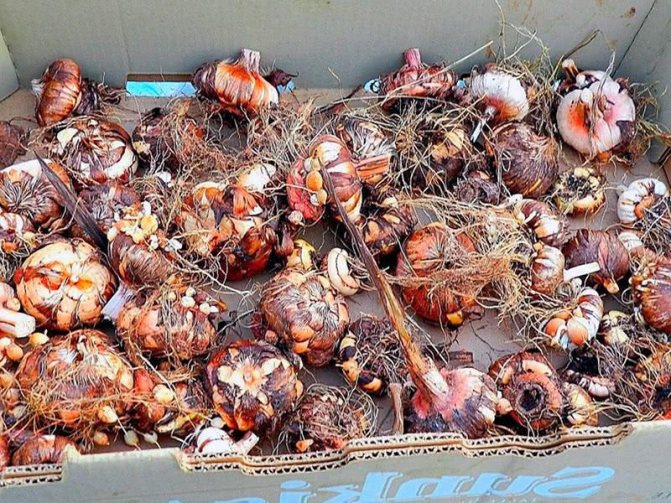

Important! During storage of the bulbs, it is necessary to control the moisture content of the peat or sand.
Storing muscari bulbs
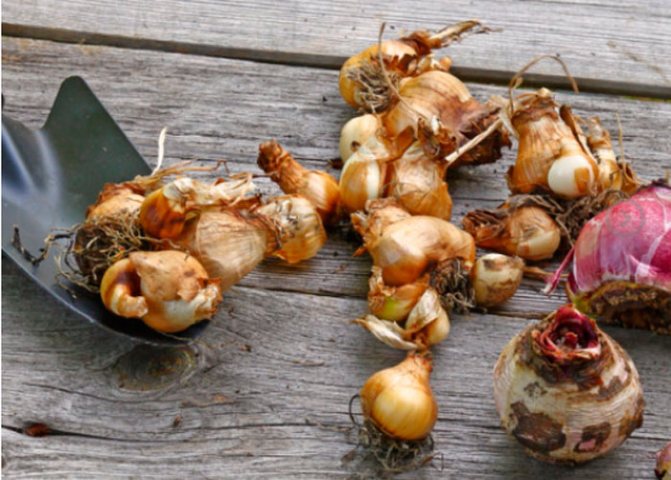

Digging the bulbs for the winter is not at all necessary, but it is possible. But in order to save planting material until spring, you need to know a few rules:
- After the leaves of the muscari begin to dry out, you need to start digging the bulbs.
- The bulbs are dried for several days, then they are placed in moistened clean sand or peat.
- Once every 7 days, it is necessary to inspect the planting material, while rotten, injured or soft bulbs should be discarded.
- It is recommended to store bulbs at an air humidity of 70 percent and at a temperature of -17 degrees.
However, it should be remembered that it is recommended to plant such a plant in the autumn, so there is no particular need to keep the bulbs until spring.
Answers on questions
Why doesn't it bloom?
If the plant stops blooming, this is the first sign that it is time to replant it or divide the bulbs.
What to do if sprouted in autumn?
Some Muscare varieties develop and germinate quickly when planted in autumn. For flowers, this does not threaten death, they calmly overwinter with leaves, and in spring they will actively begin their growth.
The use of muscari flowers for decorative purposes
Muscari is an ideal plant for creating mini-garden flower beds fenced with low wattle, birch branches or decorative pots. Blue muscari perfectly serve as a fence along the garden paths or serve as an unusual border along the paths. They can be made up as a separate array, or planted under trees or shrubs, make original compositions together with other flowers.
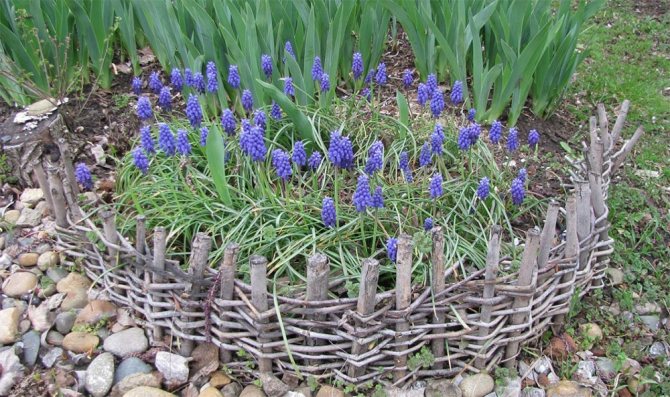

Muscari go well with a variety of colors and can be used to create original compositions.
For decorative purposes, muscari distillation is also used - artificial stimulation of the flowering process in the off-season. For this, the largest bulbs are selected. They are dug up in July at a temperature of 15 degrees, dried and stored until early September. In the period from September to January, rooting of the bulbs is done. For this, drainage is poured into the bottom of the pot and the plant is planted in a nutritious soil mixture consisting of sawdust, humus, leafy earth and a small amount of sand.
For the winter, the plants are placed in a basement or greenhouse, insulated with sawdust. In January, during the germination of sprouts, the flowers are moved for a couple of days to a room where the temperature is kept no higher than 5-8 degrees. The second stage of movement is forcing at a temperature of 15-18 degrees. At this time, watering is carried out in moderation, using warm soft water. This helps speed up the flowering process.
How to use flowers in the design of a summer cottage
There are several options for using muscari to decorate a summer cottage. The picturesque trio of blue muscari, forget-me-nots and white tulips looks beautiful. The plant can be planted in a small bucket and displayed in a composition on a flower bed.
Muscari looks good in a flowerbed arrangement.
Next to blue flowers, for example, imperial orange hazel grouses will look beautiful. Planting under bare shrubbery, such as Arabisa or Ibereika, will help create the most comfortable flower conditions. They also fill the empty spaces between tulips and daffodils.
Application
Muscari contains many useful substances that have found their application in medicine and cosmetology.
ethnoscience
Infusions from the plant are used as antiseptic and anti-inflammatory agents, help with severe stress and neuroses.
The essential oil of the flower helps with diseases of the bronchial system.
Cosmetology
The high content of essential oils in the plant allows its use in cosmetology. Creams, tonics and balms are made from extracts of plants.
Landscape design
Landscape designers and florists love Muscari flowers for their high decorative properties. In combination with other early cultures, beautiful spring compositions, alpine slides and rocky gardens are created.
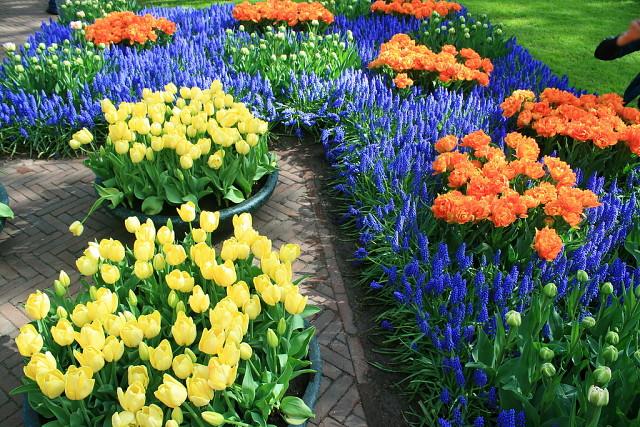

Pests, muscari diseases and methods of control
Aphids are one of the most harmful pests on muscari flowers.
Most often muscari are susceptible to infection with the yellow dwarf onion virus.In this case, characteristic symptoms appear: a green mosaic appears on the leaves, the flower arrow becomes shortened, the leaves acquire a narrowed shape and a general inhibition of growth occurs.
The plant is also prone to common cucumber mosaic. It can be distinguished by its pale green streaks and patches on misshapen leaves. Viruses are transmitted by aphids, after entering the bulb they remain in it for a long time. Virus-infected specimens must be dug up and burned to prevent contamination of other plants.
There are still no recipes for the treatment of viral plant diseases. The best way is a timely fight against aphids - their carrier. It must be carefully destroyed at the slightest sign of appearance. To do this, dilute two teaspoons of liquid soap with two glasses of water and use this solution for spraying. Radical methods of dealing with aphids are complete pruning of plants and cultivation of the soil with garden fertilizers..
Sometimes a spider mite appears on the muscari. To combat it, you will need drugs of the avermectin group, such as Aktofit, Vertimek, Fitoverm. They are used according to the instructions. Applied at an air temperature of at least 18 degrees.
Origin
The genus Muscari belongs to the Hyacinth family, in some sources it is referred to as Asparagus or Liliaceae. The flowers got their name muscari, thanks to a pleasant refined aroma, reminiscent of nutmeg wine. The first specimens of the plant were brought out in the early 17th century by the English scientist Phillip Miller. It spread rapidly throughout Europe, Western Asia and North Africa. At the moment, there are about 60 species of muscari - these are wild and cultivated varieties.
Among the people of muscarica, flowers are known by several names: mouse hyacinth, viper onion, grape hyacinth, due to the similarity with hyacinth and grape bunch. Muscari are called mouse hyacinth because of the small size of the flowers.
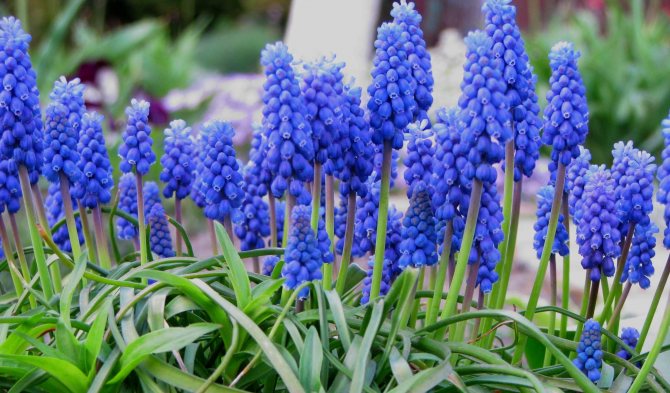

Muscari
In the wild, muscarias are found in the mountains of the Mediterranean, Crimea, Caucasus, Asia, Africa. On the territory of central Russia, 20 species of these amazing flowers are widespread.
Disembarkation rules
Before planting, it is necessary to sort out the bulbs, removing the diseased and damaged ones, treat them before planting with a strong solution of potassium permanganate or with Fitosporin.


Fitosporin
A layer of sand up to 2 cm can be added to the soil under the bulbs. It will serve as drainage for liquid and protection from pests.
It is better to plant the plant in groups, but the distance between the bulbs should be at least 4-7 cm. The depth of planting the bulbs is 6 cm. When planting, the soil should warm up to eighteen degrees Celsius.
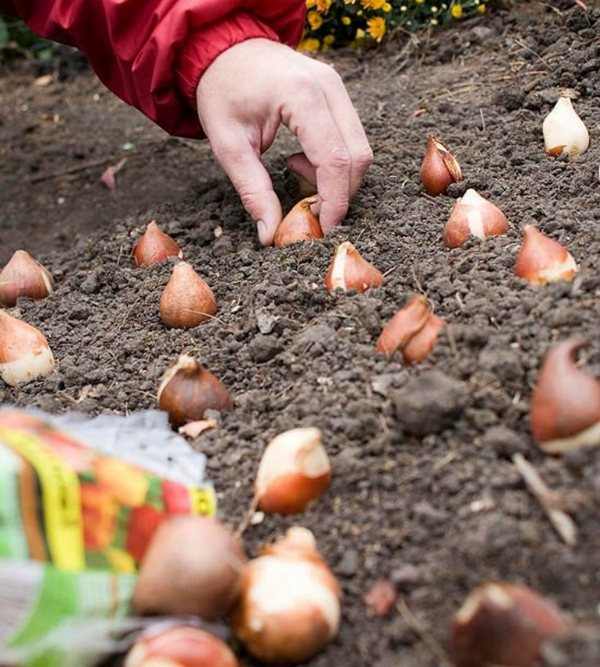

The distance between the bulbs must be at least 4 cm
On a note! If sowing is done with seeds, they are placed in the soil to a depth of 2 cm. Flowering in this case will begin only in the third year after planting.
Medicinal properties of the muscari plant
Muscari has an unusual ability to protect neighboring flowers from various pests, fertilizes the soil well. In its place, after transplanting, it is good to plant roses, peonies, daffodils - they will all bloom magnificently, decorating the site. The scent of muscari will keep flies and mosquitoes away. Flowers are great for cutting and forming beautiful bouquets.
Important! If you put a bunch of muscari in the house, it will protect the room from small insects and midges.
Choosing the right place for planting muscari in the garden, high-quality care and timely watering will help preserve a delightful flower for many years, when it will delight the eye and refresh garden beds with a fragrant aroma.
Muscari home care: forcing flowers according to all the rules
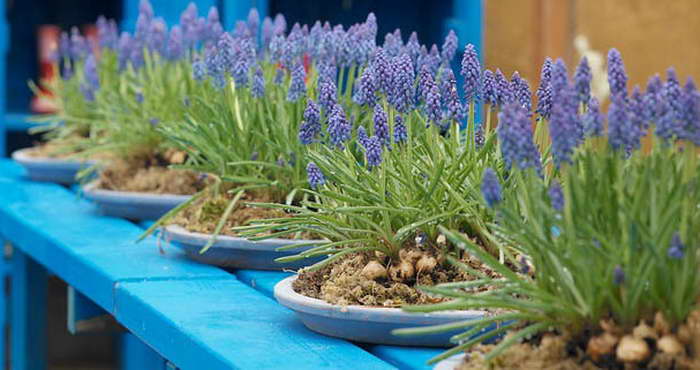

Muscari mouse hyacinth at home how to care
For distillation, you can use any type, but it is best to take Armenian muscari, nail muscari, broadleaf muscari, Osh muscari.Please note that the inflorescences will be looser during distillation, and the shade will be paler, so you should not use rare varieties - some of the beauty is still lost.
How to adjust flowering to a specific date
To time flowering to a specific date, know that the cooling period (the time required for the budding of flower buds) for most is 14-16 weeks, for Muscari Osh and Crested - 13 weeks. By this time, you need to add another 2 weeks for the very forcing of leaves and inflorescences (this Muscari Osh will need 3 weeks). For example, to get flowers for the New Year or Tatyana's Day, start cooling from September 1, Valentine's Day, or March 8 - in early October.
The cooling period involves two stages: dry (we store the bulbs in peat or sand at a low temperature) and wet (we plant and start watering little by little).
Muscari species Armenian, grape-leaved and broadleaf are kept at a temperature of 9 ° C with a plus sign for 5 weeks, another 11 - at a temperature of +5 ° C. Fifteen weeks are allotted for dry storage, 2 weeks of bulbs need to be grown in a pot with watering. For Osho, it will take 5 weeks at a temperature of 9 ° C, another 9 at + 5 ° C, 6 weeks are allotted for dry storage. To prevent the plant from stretching, in the last stages of cooling, you can lower the temperature to + 1-2 ° C.
Soil for planting muscari bulbs at home
Take a light, neutral substrate for planting: a mixture of peat and compost with the addition of sand, dolomite flour or charcoal. Use shallow containers with a diameter of 10-12 cm. Lay a drainage layer on the bottom, fill it halfway with earth and plant the bulbs close to each other (they will fit about 6-10 pieces).
Forcing rules for muscari flowers
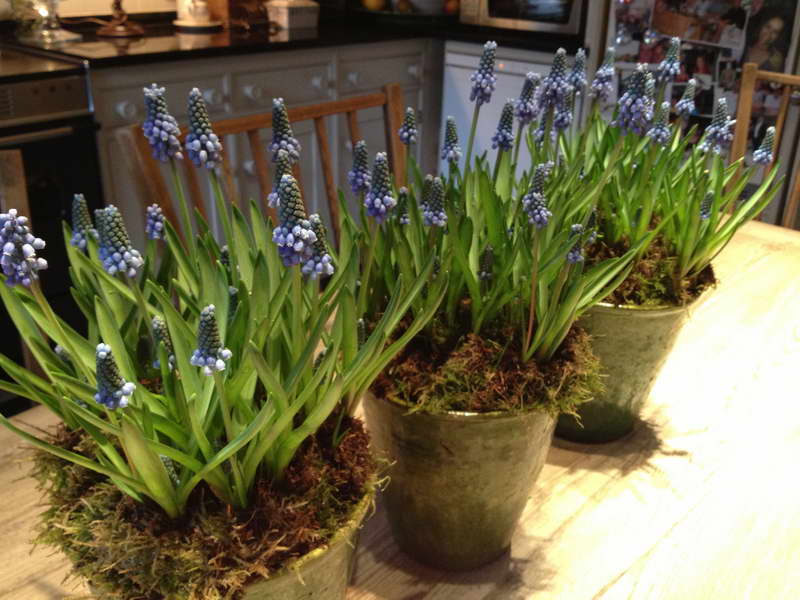

Muscari in a pot growing and care at home
The distillation itself takes 10-12 days. After the end of the cooling stage, we transfer the pots to a greenhouse or other room with a temperature of 10-12 ° C. The first day we keep it under diffused lighting, then we increase the temperature to 15 ° C and put it on the lightest window sill or turn on phytolamps in the greenhouse, placing it at a height of 30-50 cm above the plant. Turn the backlight on and off at the same time. Coolness and good lighting are extremely important, water sparingly, if you want to plant the bulbs in the ground after forcing, feed once with a solution of calcium nitrate with a concentration of 0.1%.
It happens that plants are ready for flowering earlier than the intended date: 3-4 days can be kept at a temperature of + 1-2 ° C. Then return to warmth and water again. Muscari bloom in the room for no more than 10 days.
If the distillation needs to be timed to a later date (Easter, May holidays), the "ice" method is used in relation to Armenian muscari. The bulbs are stored at 23 ° C until October 1, and at 20 ° C until the end of December. This is followed by dry storage at 9 ° C, it will take 1.5 months for rooting at the same temperature. After the formation of the root system, the bulbs are frozen at -1-2 ° C until the desired time. To defrost, gradually increase the temperature and put on a pause for longer than usual.
Muscari has faded: what to do next?
Once forced, the bulbs can be stored until autumn planting. Cut off dry stalks and feed the muscari with bulbous fertilizer. Keep in good light cool (about 15 ° C) until the leaves turn yellow, then maintain normal room temperature and wait for the leaves to die. Pick the bulbs out of soil and store in dry peat at 17 ° C. You cannot expose them to re-distillation; in the fall, plant them on the site. In the future, take the largest ones from the daughter bulbs and plant them; after 2-3 years, material for distillation can be selected from these plantings again.
Viper onion - for being a bulbous plant
... and contains poisonous substances. In the sunny glades, where these flowers grow, families of vipers often live.
In the natural environment, they grow in warm, humid countries. Southern and Central Europe, Mediterranean countries, Caucasus and Crimea.
An interesting history of the appearance of these flowers in Europe. Back in the 17th century, a ship carrying goods from hot countries, including muscari bulbs, was wrecked off the coast of the Netherlands. They were washed ashore, they sprouted in the warm sand. This is how people learned how to grow such flowers.
Currently, these delicate flowers are used by landscape designers and gardeners to decorate their gardens, city beds, sidewalks, greenhouses, parks and gardens.
Muscari flowers photo gallery
Most interesting articles
- Forget-me-nots - blue tenderness in the garden
- Aquilegia is a magical, non-whimsical flower
- Cineraria - smoky beauty
- Sedum - planting and leaving
- Buttercups garden - planting and care
- Petunia is the most unpretentious flower
- Annual flowers for a summer residence with photos and names
- Willow loosestrife - tears pleasing to the eye
- Garden geranium
- Flowers for a flower bed are the best
- Mallow - all the secrets of cultivation
- Lilies of the valley - a wonderful scent of spring
What time to plant?
Experienced flower growers suggest planting muscari in the fall - from late August to October.
Muscari are sometimes grown in pots for spring holiday sales. After flowering, you can transplant it to a secluded place. By the fall, you can dig out the strengthened bulbs and use them for planting in the spring.
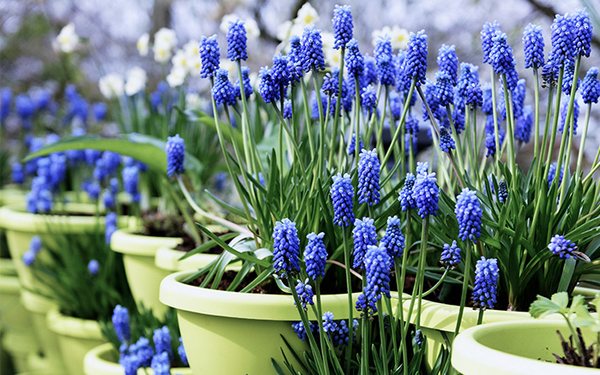

Muscari is also grown in pots
When purchasing material for planting in a store, you must carefully examine the shoots. They should show no signs of parasite infestation.
On a note! Sometimes in spring, nurseries offer flowering muscari seedlings. On the advice of the nursery staff, they can be immediately planted in the soil in a permanent place.
Blossoming Muscari Seedlings Available
What you need to know about Muscari?
Planting is carried out in the fall, until the end of October.
Even before the leaves appear on the trees, the first inflorescences appear in early spring.
On a note! Muscari grows well in sun or partial shade.
Almost any soil is suitable, but with a good permeable layer. Therefore, viper onions do not like clay and peat.
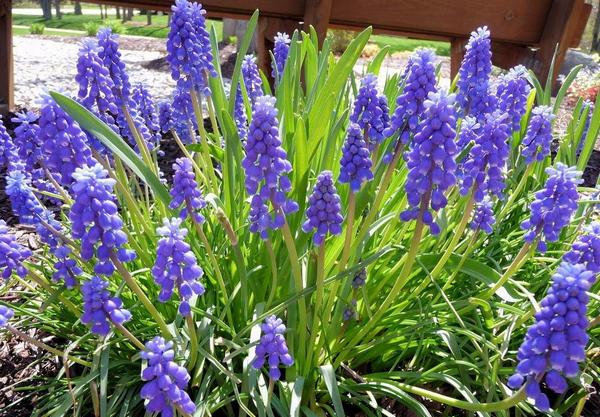

Muscari grows well in the sun
The growing season coincides with the period of spring showers, due to which the plant has to be watered only in the case of a winter with little snow and a dry spring. During the dormant period, the plant is not irrigated with water.
On a note! In autumn, you can apply organic fertilizers when digging: 5 kg of bait is consumed per square meter.
They feed the plant in autumn
Reproduction occurs by self-seeding or vegetatively by daughter bulbs.
Pests: slugs, spider mites, voles.
Diseases: green cucumber mosaic.
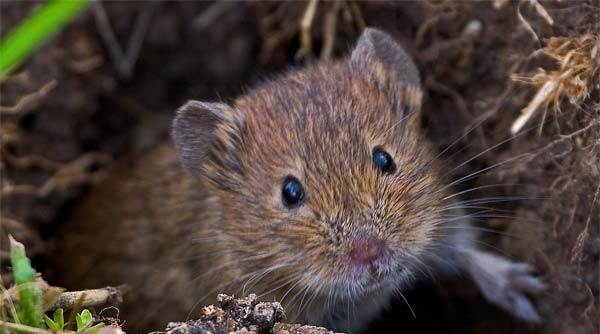

The plant can suffer from voles
Breeding muscari
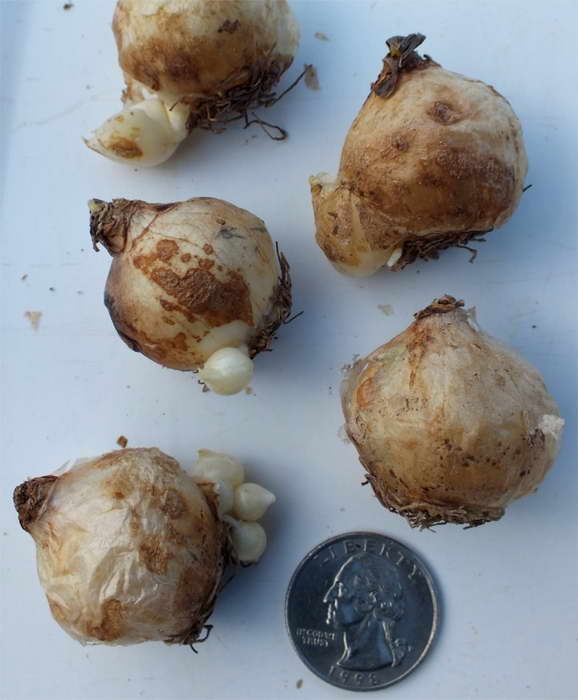

How muscari reproduces photo bulbs with babies
Most often, muscari are propagated vegetatively by daughter bulbs. One mother forms a nest of 30 bulbs over several years of growth. We dig it out and plant it from mid to late October. The landing method is described in detail above.
Muscari gives abundant self-seeding, which is why after flowering it is recommended to cut off wilted peduncles. If you do not control this process, the plantings will be dense, lose their decorative effect, and become like a weed.
Plants grown from seeds are more resistant to diseases and pests. To renew the muscari, leave a few stems to collect the seeds. They remain viable for no more than 12 months, it is better to sow immediately before winter. Dig up the area with humus, level it, sprinkle the seeds, cover it with a rake, cover with a layer of mulch. In the spring, seedlings will appear that look like green strings, thin out when they grow up. The first flowering will come in 2-3 years.
Description of the plant
Muscari is a small-bulbous perennial with a height of 10-40 cm. The underground part of its stem is an oblong bulb 3.5-5 cm long and 2-4 cm in diameter.The bulb is ovoid and covered with thin white scales. A bunch of thin roots grows on its bottom.
In early spring, the plant forms a rosette of linear dark green leaves 17-20 cm long. Each bulb grows 2-6 leaves. They have a narrow linear or oval shape with a solid edge and a pointed end. There is no drawing on the surface of the sheet.
The flowering period, depending on the variety and weather conditions, starts from late March to early June. It lasts 1-2 weeks. Initially, a fleshy, erect peduncle grows from the center of the leaf rosette. It has a cylindrical shape and is light green in color. Closer to the flowers, the stem acquires a mauve shade.
The racemose inflorescence consists of many small flowers located close to each other. Its length is 7-8 cm. A single flower with a spliced corolla resembles a lily of the valley in structure. The edges of the petals of the barrel-like flowers are strongly curved and divided into 6 lobes. The color is white, lilac, blue, blue or purple. Sometimes there is a contrasting border along the edge. During flowering, most varieties exude an intense musky aroma.
The inflorescence begins to bloom from the lower flowers. Above are sterile buds designed to attract insects. Bees and butterflies get nectar from the tube with their proboscis and pollinate the ovary. After pollination, the fruit is formed in the form of a spherical or heart-shaped seed capsule with fleshy walls. Inside are small dark brown seeds.
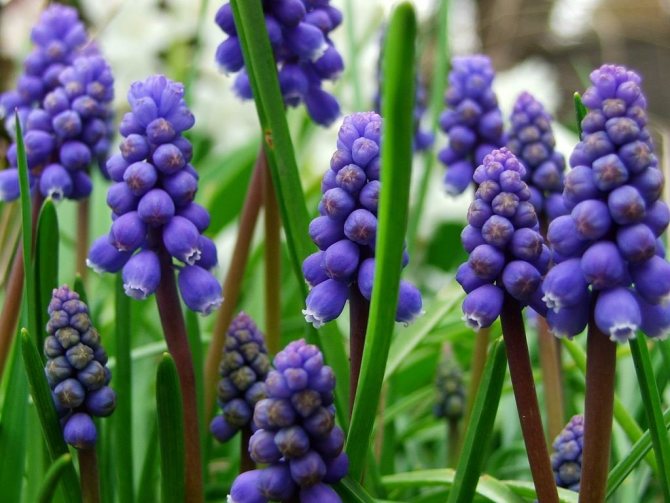

Photo muscari
Transfer
Muscari can be propagated in two ways.
The first is the use of seeds. After ripening, the seeds are harvested. Germination capacity lasts up to twelve months. Sowing is carried out in the fall, and shoots will appear by the spring. But flowering will have to wait 3-4 years.
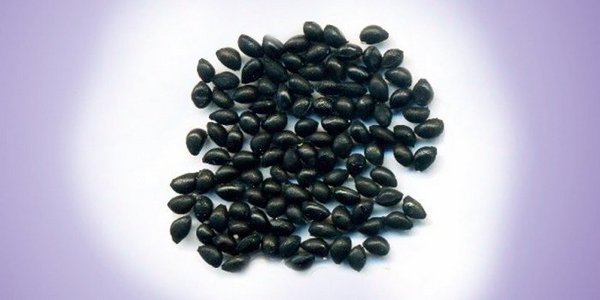

Muscari can be propagated by seeds
Reproduction in a vegetative way is carried out by planting young bulbs. A prerequisite is that a bush growing in the same place for 5-6 years can become a source for transplantation.
In September, an onion with "babies" is dug up, of which there are up to 30 pieces per copy. They are separated from the main bulb, dried in the sun and treated with preparations to stimulate the roots.
On a note! Next, they are planted according to the above scheme.
"Children" are separated from the bulb, and then planted
It should be mentioned that muscari can reproduce by self-seeding. To maintain the shape of the flower garden, you need to monitor the number of flowers. Excess peduncles can be removed after the flowering period.
When to transplant muscari? Reproduction by children
Mouse hyacinth muscari reproduction by children photo
Muscari propagation is very simple. Usually this operation is combined with a transplant. First of all, you should mark with pegs the place from which you will transplant the plants. Since by the time of transplantation, there will be no traces of them on the ground - the plants are in hibernation. When to plant your muscari? Have been doing this since mid-summerso that the bulbs have time to take root before wintering.
- Carefully dig in a lump of earth with a shovel in the spot you see and break it, separating the bulbs. They are carefully sorted out, removing the sick and dry.
- The bulbs are sorted by size, large ones can be left for forcing, the smaller the bulbs, the closer they are placed from each other.
- Very small ones can be put next to several pieces.
- Planting muscari looks more attractive if the plants are arranged in groups. To do this, you can make grooves in the shape of a circle, or lay out the onion in flocks, for example, 3 pieces side by side, 10 cm more 3, etc.
They are planted in prepared soil, to which humus is added. Grooves are made, on the bottom of which sand is poured with a layer of 2 cm and spilled with water. The bulbs are laid out along the groove, covered with compost on top. The more nutritious the soil at the planting site, the faster the muscari will grow and the more colorful the flowering will be.
Planting muscari in spring
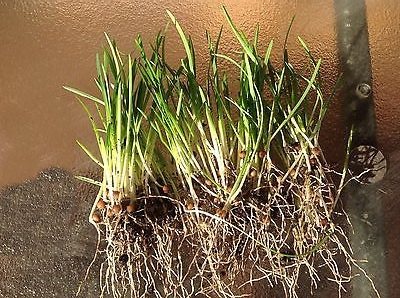

Muscari flowers planting and care photos
Sometimes you have to replant muscari at the wrong time - during flowering, in the spring. They sometimes grow actively and interfere with other cultures. Gently shovel in a flock of muscari and transfer it to a more convenient place, which is prepared in advance by introducing organic fertilizers. The hole is made to the size of an earthen lump with muscari, which is carefully transferred directly on a shovel, sprinkling with soil around the circumference. After that, the plants are thoroughly watered. Usually, with this method of transplanting, muscari bloom again next spring without problems.
How to plant muscari in spring, the video will tell:
For all unplanned transplants, so that the plants suffer less, it is better to transplant them in the evening, watering them abundantly. if possible, in the first week it is better to shade the landing.
Growing conditions How to plant and care for muscari
Muscari flowers planting How to care for mouse hyacinth
Muscari multiply very quickly, forming luxurious floral carpets. During the season, one mother bulb forms a whole nest. One rule for all garden species should be observed - they do not tolerate stagnant melt water, lowlands. Otherwise, muscari grow without problems in any area. The attitude to the sun's rays does not matter much, since the period of their active growing season falls on the time when the other green fellows in the neighborhood are just about to wake up from hibernation and in no way interfere with our upstarts.
- When planting, you should count on the fact that the mouse hyacinth will grow without transplanting for several years in one place, and it is good to fill the soil with organic matter and compost.
- A little sand should be added to the bottom of the planting holes.
- The bulbs are buried to a height equal to three of its diameters.
- Watering is not relevant for viper onions - there is enough moisture in the ground after the snow melts.
- If the plants have not been transplanted for several years, they should be fed with complex fertilizer during the flowering period, after thoroughly moistening the soil.
Why don't muscari bloom?
When to dig out the muscari
If there is a deterioration in flowering or its complete cessation - the plant only releases leaves, this is an impetus to the fact that it is time to transplant and divide the curtain.
It should be borne in mind that a place in muscari at the beginning of summer may be empty, it can be occupied by annual representatives of the natural kingdom or combined planting with other perennial plants that bloom much later.
Output
Muscari has a beneficial effect on the flower neighborhood. The plant fertilizes the soil, scares away the smell of flies, mosquitoes. Cut flowers retain the same properties. In the place where the muscari is grown, you can plant other flowers, for example, roses, dahlias, daffodils.
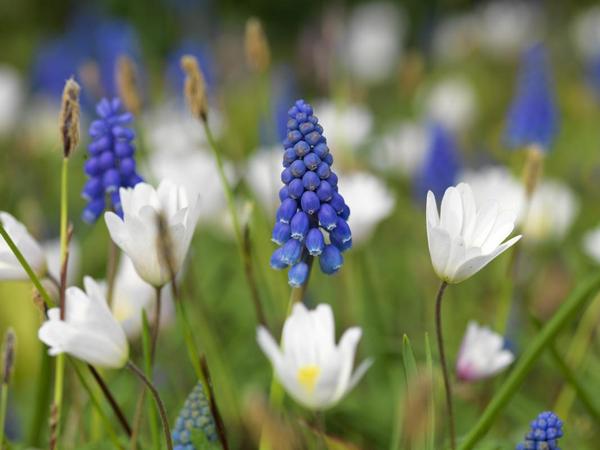

Muscari is a good neighbor for other flowers
By choosing the right color scheme for muscari and neighboring plants, you can create a beautiful composition in a flower bed.
1. Seven Secrets of Success:
| 1. Growing temperature: from the moment of planting the bulbs until flowering, the plant is kept at a temperature of 18 - 24 ° C, the cool dormant period should take place in a temperature range of 10 to 13 ° C. |
| 2. Lighting: Must be shaded from direct sunlight, location must have a lot of reflected sunlight. |
| 3. Watering and humidity: during the growing season, water in such a way that the top layer of soil about 5 cm thick dries up with watering. Air humidity is high. |
| 4. Features of the: Mouse hyacinth is ideal for forcing. With the help of competent care, you can get a lively bouquet for any desired holiday. |
| 5. Priming: very loose and organic soil with a lot of nutrients and acidic pH. |
| 6. Top dressing: During the growing season, feed the mouse hyacinth with liquid fertilizer for flowering plants every 2 weeks.During the dormant period, feeding is not carried out. |
| 7. Reproduction: seeds sown in spring, dividing large bushes during spring transplantation. |
Botanical name: Liriope.
Mouse hyacinth flower - family... Liliaceae.
Where grows... Japan, China.
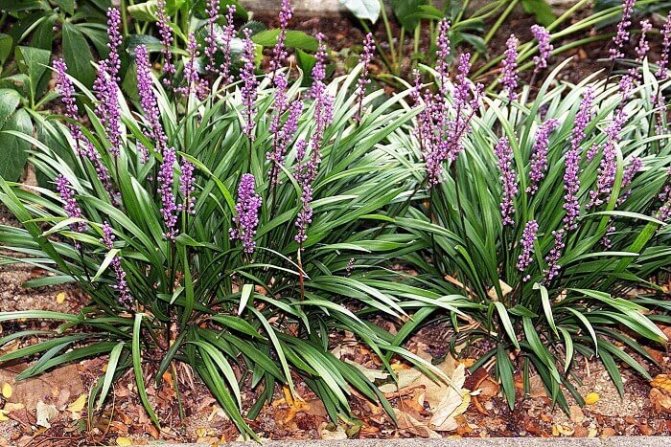

Description... Mouse hyacinth or muscari or viper onion is a small genus of herbaceous, perennial plants, which consists of only 6 species. Liriope is characterized by dense basal leaves and resembles a hummock. The leaves are arcuate, linear, green, up to 45 cm long. Variegated varieties have light longitudinal stripes. Tall, leafless peduncles appear in the center of the rosette and bear inflorescences of many small, blue, white or lavender flowers at the top.
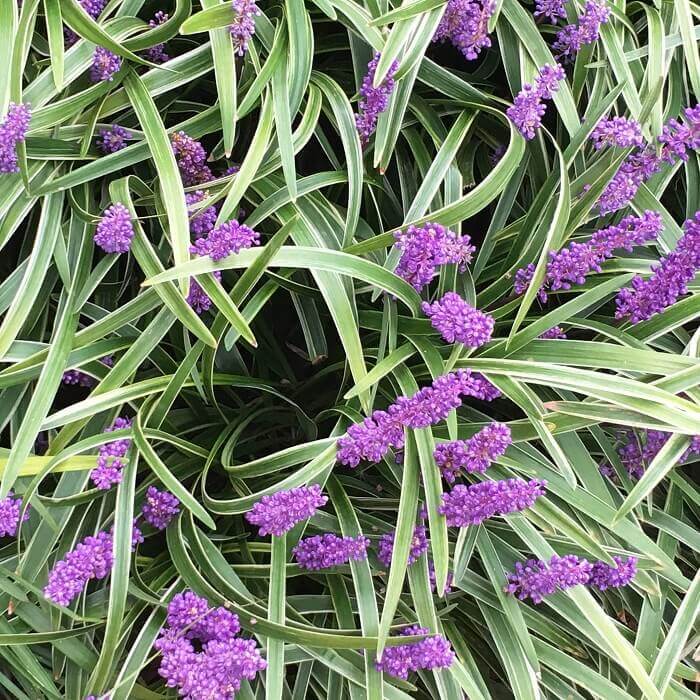

Height... About 40 cm high.
Leaving during flowering
The flowering period is 3-4 weeks, and no special care is required during this period. It is only necessary to periodically loosen the soil a little, weed, remove faded peduncles, if necessary. You do not need to cut the leaves, because they help the plant gain strength for wintering.
Benefit and harm
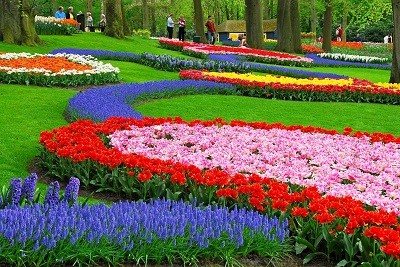

Small flowers adorn floristic compositions. They give the bouquets an enchanting atmosphere. They are also used in landscape design. These lovely flowers decorate spring flower beds.
Thanks to continuous flowering for a month, the plant looks great against the backdrop of an emerald lawn or a sunny lawn.
Flowers look great in a composition with daffodils, lilies of the valley, dwarf tulips, crocuses, primroses, forest trees, hazel grouses, forget-me-nots or chionodox.
Muscari in landscape design
Low-growing plants look beautiful in the curb and on a well-groomed alpine slide, especially in groups. You can arrange a neat lawn or a clearing in front of the house; during flowering, you will get a chic bright carpet.
In summer, we admire the many bell-shaped flowers. They grow in meadows, forest glades, along the banks of rivers, lakes and always attract our attention. But special admiration appears when the snow only has time to melt, you see gentle muscari, reminiscent of miniature hyacinths, come to life among the still sleeping flower beds of your own plot. These touching plants are also called mouse hyacinths and viper onions, and they belong to the genus bulbous.
Wintering
The plant does not require shelter for the winter. But in order to avoid freezing, the flower can be made mulching... Covering material is poured around the root system. You can use straw, wood chips, tree bark, dry grass, sawdust. The mulch must be spread on the surface of the ground. Before the procedure, the soil is loosened and watered abundantly. You can also mix soil with purchased soil for strawberries, cucumbers or tomatoes.
This protection prevents the evaporation of water from the soil, protects the root system from frost and freezing. With the correct ratio of mulch, nutrients, vitamins and soil acidity are preserved. Mulch slows down or eliminates the growth of weeds and improves the efficient work of microorganisms.
Reference!
Mulching protects Mouse Hyacinth from pests. But you can't do the mulch too high, as dry material can serve as burrows for rodents.
Muscari care
Muscari is a very unpretentious flower, and caring for it is not difficult. It is worth watering them only when planting and germinating. But, more often than not, in this autumn or spring season, the land is wet from rains or melting snow.
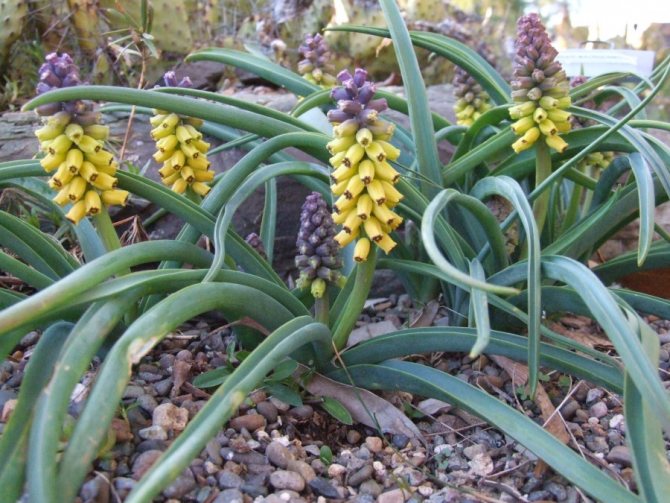

In winter and summer, watering is not required because these seasons are Muscari dormant periods. Watering is necessary only when there was little snow in the winter, and the spring is sunny and not rainy.
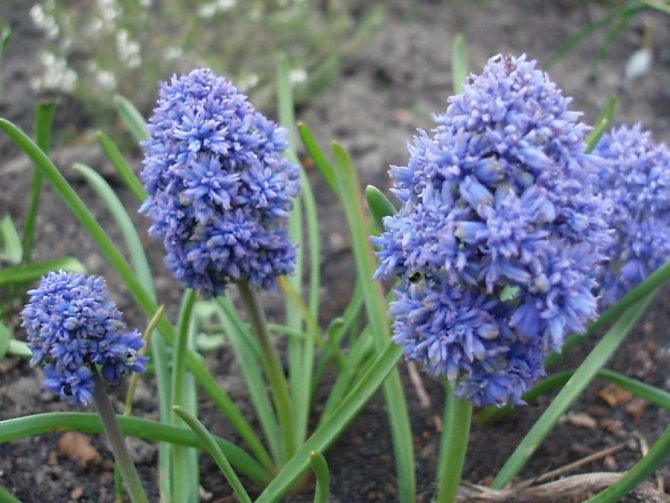

Description
Muscari is a perennial plant, belongs to the genus bulbous, to the asparagus family. It has many types and many of them are grown as ornamental.
Their small, light bulbs grows, up to 30 mm long.The ovate bulb stores nutrients for early flowering in spring.
In early spring, narrow ribbon leaves appear near the root system, up to 15-18 cm long, about six pieces. In autumn, they also grow again and can overwinter under a layer of snow.
On the bare trunk, small flowers appear in the form of a bell or a barrel, which are collected in cluster inflorescences in several rows. Various colors, there are white, yellow, pink, lilac, sky blue.
In the middle there is a fruit in the form of an oval capsule that contains black shriveled seeds. If these seeds are harvested and sown throughout the year, they will produce new plants. Seeds used after a year of harvesting do not germinate.
They reach a height of 25-30 cm.
The plant is absolutely unpretentious to care for.
How to properly plant muscari in open ground
Proper planting should ensure not only the fulfillment of the requirements of the conceived composition, but also create optimal conditions for the growth of small plant bulbs. The best option for their placement is a small hill. It will not accumulate water that is dangerous for the plant.
Timing for planting bulbous plants
The best time to plant mouse hyacinth is autumn
- In the fall, you can dig up a site well
, planned for planting a flower, remove weeds, apply the necessary fertilizer. - It is convenient to dig out overgrown bushes, separate the babies from the mother's bulbs.
Take your time to carry out all the work on the preparation of planting material. There is no need to create conditions for its storage until next year. - Cold season conditions are automatically created
needed by the bulbs for effective flowering.
Site selection, soil preparation
The plant is not demanding on growing conditions. It develops well in sunlight, shade, partial shade. They can live in the chosen place for 10 years.
There are simply features in the timing of flowering plants planted in different areas:
- Places with bright sunlight create conditions for active growth immediately after the snow melts.
During this period of the year, there is no large grass, few flowering plants, no foliage on the trees that create shade. Such plantings bloom very early. A favorite place for a plant will be the beds located in the place where the sun's rays fall on them from the southwest. - Trunk circles of fruit and other trees.
Almost all types of muscari manage to please us with their beautiful bells before the massive bloom of the garden. They have enough sun, moisture. - Landing on the lawn.
In the fall, remove the sod, dig a hole of the desired size. Bulbs are planted in it, covered with a removed piece of turf, and the surface of the lawn is leveled. In the spring, until it is time to mow the lawn, the flowering bushes look unusual. They have time to bloom before the grass is cut.
Soil preparation
It consists in digging and applying organic fertilizers. The plant does not have any special requirements for its type. Grows well on any type of soil. Muscari flowers growing on light, medium, slightly acidic (pH 5.9-6.3) soil are brighter and more expressive. Especially if the plantings are located on high lawns in the form of alpine hills.
Soil processing and preparation
Soil cultivation consists in creating a loose soil that does not allow stagnant water. To do this, perform the following activities:
- Dig well, removing weeds.
- Organic fertilizer is introduced in the form of compost, humus.
Open ground planting process
- Prepare planting material.
To do this, carefully inspect all dug or purchased bulbs. Sort out patients. It is better not to plant darkened and damaged ones. It is better to use them separately for recovery, recovery. - Treat all planting material with any fungicide.
You can stand them for 30 minutes in a weak solution of carbaphos, potassium permanganate. Store-bought bulbs are usually ready for planting. - Prepare holes for group planting.
Usually, several bulbs are planted together, keeping a distance of about 5 cm between them. - At the bottom of the holes, drainage from expanded clay, coarse sand.
The plant does not like stagnant water. Water the prepared hole abundantly before planting. - The planting depth of large bulbs is about 8 cm.
Small ones can be planted to a depth of 4 cm. - You can plant bulbs in a single trench rather than in separate holes.
Content
- Listen to the article
- Description
- Growing muscari in the garden
- Planting muscari When to plant
- How to plant
- How to care
- Armenian Muscari (Muscari armeniacum)
Flowers in garden design
Bright and varied shades of plant inflorescences are used with pleasure by landscape designers when decorating garden plots. Muscari go well with daffodils and tulips.
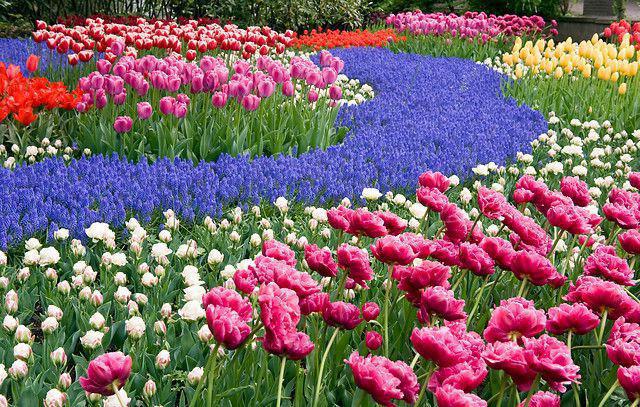

Long early spring flowering (some varieties decorate the flower bed for about four weeks) gives free rein to the imagination to decorate the site. Experts take into account another feature of different varieties - the beginning of flowering does not coincide with them. With careful selection, you can ensure the beauty of the flower bed for a long time.
They are used to decorate alpine slides, borders, wild stone compositions, around small ponds. Neighborhood with begonias, tricolor violets, lobularia will help hide the wilting of muscari. In one place, unpretentious flowers can grow up to 10 years.
Garden on the windowsill
The lack of a summer cottage will not be an obstacle for an amateur florist to grow muscari. Planting and grooming at home will not cause problems even for beginners.
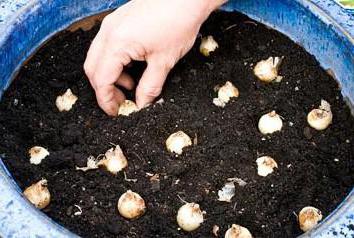

There are several tricks to get the desired result:
- "Cold storage" - the bulbs are placed in the refrigerator for 3-4 months before planting in a pot;
- drainage from large pebbles is arranged in pots at the bottom;
- the soil is taken as fertile and fat as possible;
- plants need diffused sunlight;
- provide high air humidity;
- irrigation of the soil is carried out as the soil dries up;
- for visual effect, you need to take as many pots as possible with flowers.
Description of muscari
It is a perennial flower with cylindrical, oblong or barrel-shaped perianths. Blooms in April - May - 20 days. Flowers with six fused petals, collected in a brush, which is located on a high stem, blue, white, blue, azure, cornflower blue shades. They have a delicate pleasant aroma. Basal, pointed leaves with parallel venation form rosettes up to 17 cm.Oval bulbs with light outer scales, 20 mm in diameter, 15-25 cm long.
Planting muscari
Before planting, hold the muscari bulbs in karbofos and a solution of potassium permanganate. Solid bulbs are allowed for planting, without mechanical damage and stains. Carefully inspect and process each bulb, whether you bought it or grew it in your garden. To plant the muscari, remove the top layer of soil to a depth of 7 cm. The size of the pit corresponds to your design idea. Muscari are planted in groups, as a border, or in combination with other flowers (as shown in the photo). Plant muscari bulbs 10 cm apart. Place the smallest bulbs along the edges of the flower bed, at a depth of 3 cm and a distance of 5 cm between adjacent plantings. Before planting muscari, water the garden bed, pour 3 cm of coarse sand on the bottom of the hole to ensure water drainage.
Features of planting and care
Muscariki are flowers that are undemanding in care and growing conditions. Several basic principles of agricultural technology should be adhered to:
- The choice of planting material. Muscari are propagated by bulbs and seeds. Growing a flower from bulbs is much easier and more efficient. You need to carefully choose them - the bulbs must be healthy and whole. Before planting in open ground, the material should be soaked in a solution of potassium permanganate for disinfection.
- Landing time. Flowers should be planted in late summer - early autumn. Muscari leaves should dry, bulbs should ripen before the onset of cold weather.
- Choosing a landing site. Flowers can grow in almost any soil. An exception may be clay soils or areas prone to clogging. In a sunny place, muscari bloom more abundantly and grow faster.
- Landing. Organic fertilizers are introduced into the soil: compost, humus, ash. The soil is dug up, holes are made, 6-9 cm deep at a distance of 15 cm. If the soil is heavy, it often clogs up, sand is added to the holes for drainage. The bulbs are planted, carefully sprinkled, lightly tamped.
- Fertilizer. In the fall, the flowers are fertilized with organic matter; in the spring, you can use mineral nitrogen-potassium agents. But experienced gardeners say this is not necessary.
- Watering. Humidification is carried out only under conditions of urgent need - with prolonged heat or prolonged absence of rain.
Additional care is the thinning of muscari bushes, removal of dry peduncles and leaves, weeding, regular loosening.
Potted hyacinth
Interesting. Hostas, tulips, daffodils are excellent neighbors for muscari.
Spread
Muscari has a very wide distribution area around the globe. Prefers to grow on mountain slopes, forest edges, in alpine meadows. It can be found in the steppe regions of Europe, Asia, North Africa.
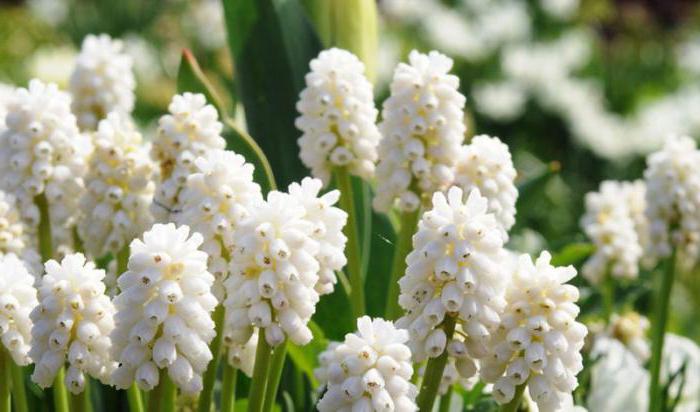

There are about 60 types of flowers. On their basis, cultivars have been developed that are widely used in horticulture. Indoor floriculture did not pass their attention either. Many varieties grow well at home.

